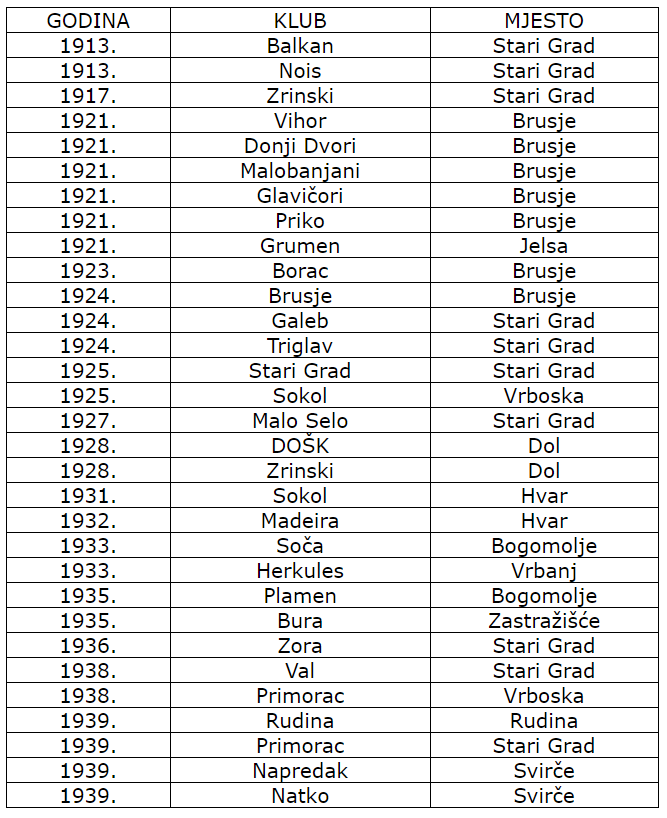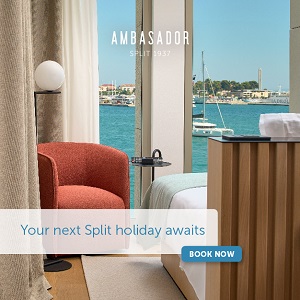Winter Tourism on Hvar: Dolphins Come to Play in the Harbour (VIDEO)
December 9, 2019 - Some very welcome guests caught on webcam this week in the port of Hvar - dolphins!
Technology is increasingly on hand these days to record things which may otherwise go undetected.
The popular Hvar Live webcam, which observes life in various parts of the Hvar harbour 24/7 picked up some friendly visitors from the sea - Hvar dolphins!
Surfacing times: 00:20, 00:26, 00:33, 00:40, 00:48, 01:24, 01:32 and 01:38 Big thanks to Tom Bowen for spotting the dolphins, the camera was unfortunately on automatic operation. So this was recorded by accident and saved by rewinding back, after Tom mentioned the time in the chat.
Tourists in Stari Grad in 2005 were treated to an unusual sight as a dolphin swam into the town's deep bay and came right into the town's harbour by the school, much to the delight of the local children and tourists alike. While its arrival was welcomed by people who came out in large numbers to see the dolphin, it was not such a happy experience for the dolphin, who was clearly distressed at not being able to find its way out. The harbourmaster called in experts, and eventually the dolphin was assisted back out to sea.
The most common contact tourists have with dolphins on Hvar is on the tourist boats between Jelsa and Bol, which seem to attract only lots of dolphins, but also many who are in playful mood with the tourists - see below.
Barba Andro Turns 103 on Hvar, Still Mending Fishing Nets in Stari Grad
November 30, 2019 - As Barba Andro turns 103, what is the secret for a long and fulfilled life?
He was born during the First World War and served in the Second World War, and for many, many years, he has been one of the most recognisable icons of Stari Grad on Hvar.
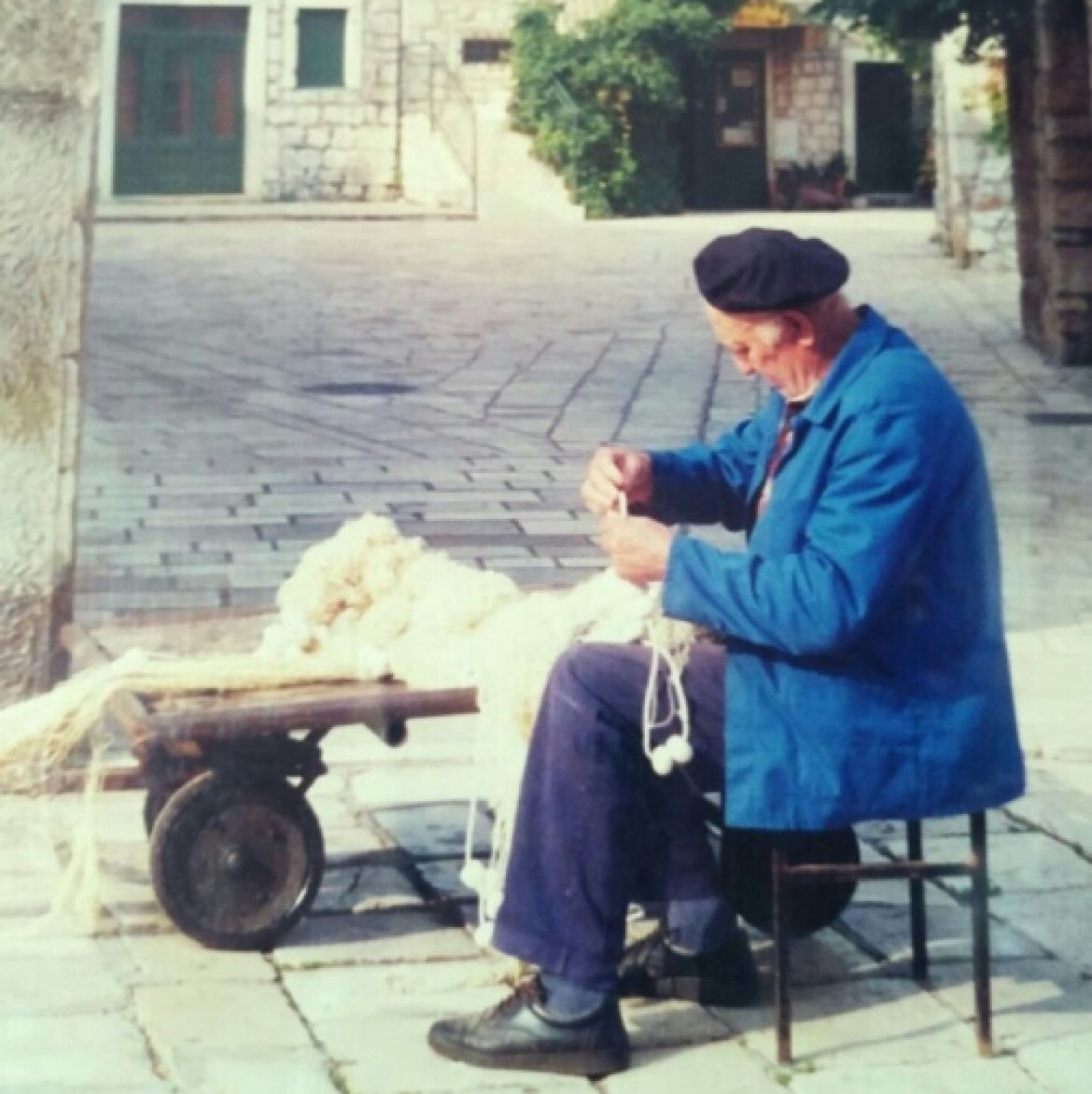
Barbe Andro Muse, a fisherman by trade, whose dedication and expertise in repairing fishing nets over many years has made him one of the most-loved characters in Stari Grad. For many years, I would admire him from afar at Pizzeria Marko, as he worked tirelessly away repairing nets all day long, cigarette never far from his mouth (he has been a regular smoker for over 80 years).
Everyone is allowed one vice, but perhaps the secret of Barba Andro's longevity is a combination of the temperate Hvar climate, its UNESCO Mediterranean Diet, including plenty of fish caught by himself over the years, the relaxed 'laganini' lifestyle, and a great work ethic.
In honour of Barba Andro's 103rd birthday, local TV reporters Maja Zrnic and Jurica Vodanovic put together this wonderful tribute to him, reflecting on his many years on Hvar and his dedication to those fishing nets, which he still diligently repairs without the aid of glasses.
Happy 103rd birthday, Sir!
To learn more about the magic of Stari Grad, here are 25 things to know.
Advent on Hvar: Programmes for Hvar Town and Stari Grad
Advent on Hvar begins on December 1, 2019 - the full programmes in Hvar Town and Stari Grad.
One of the undoubted hits in Croatian tourism in recent years has been the late-season boost provided by Advent. Something hardly celebrated in tourism terms until just a few years ago, the rise and success of Advent in Zagreb has trickled down to the rest of the country, and seemingly every town now has its own December programme.
Advent on Hvar is no exception. For those of you used to the summer beaches, seeing a Christmas tree in the main squares of the towns can be an amusing sight. One of the things I always appreciated about Christmas on the island coming from Manchester was the lack of commerciality on the island. The Christmas tree in Jelsa used to go up on the main square ten days before Christmas. And a minimal exchange of presents and hearty family lunch, and that was Christmas. Much better.
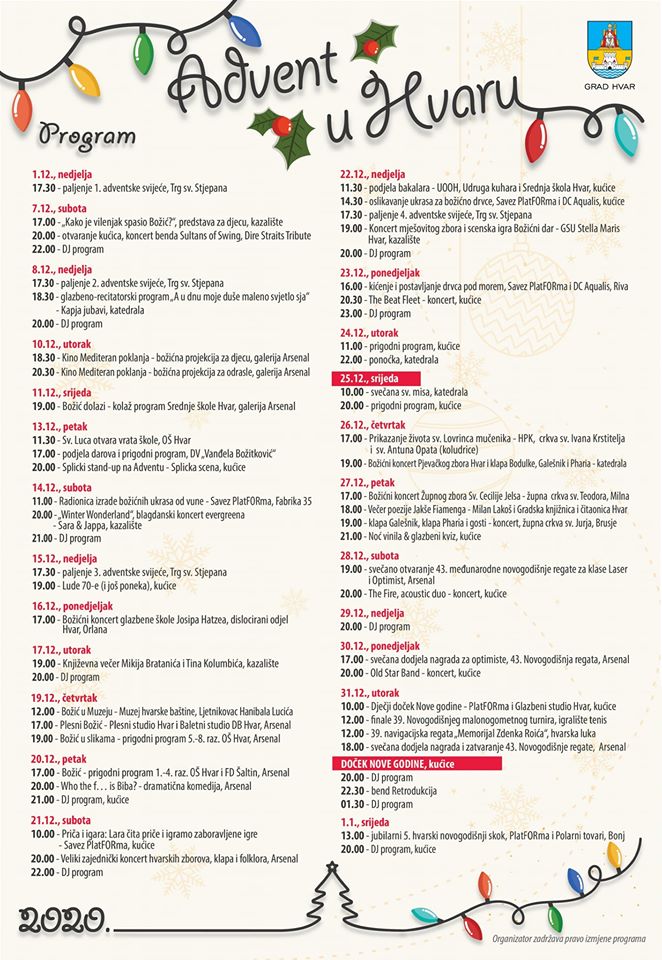
Advent on Hvar has also gained in popularity in recent years, and this year's festivities kick off tomorrow in both Hvar Town and Stari Grad.
The full programmes are above and below - a nice break from those long winter evenings before Easter and the dawn of a new tourist season.
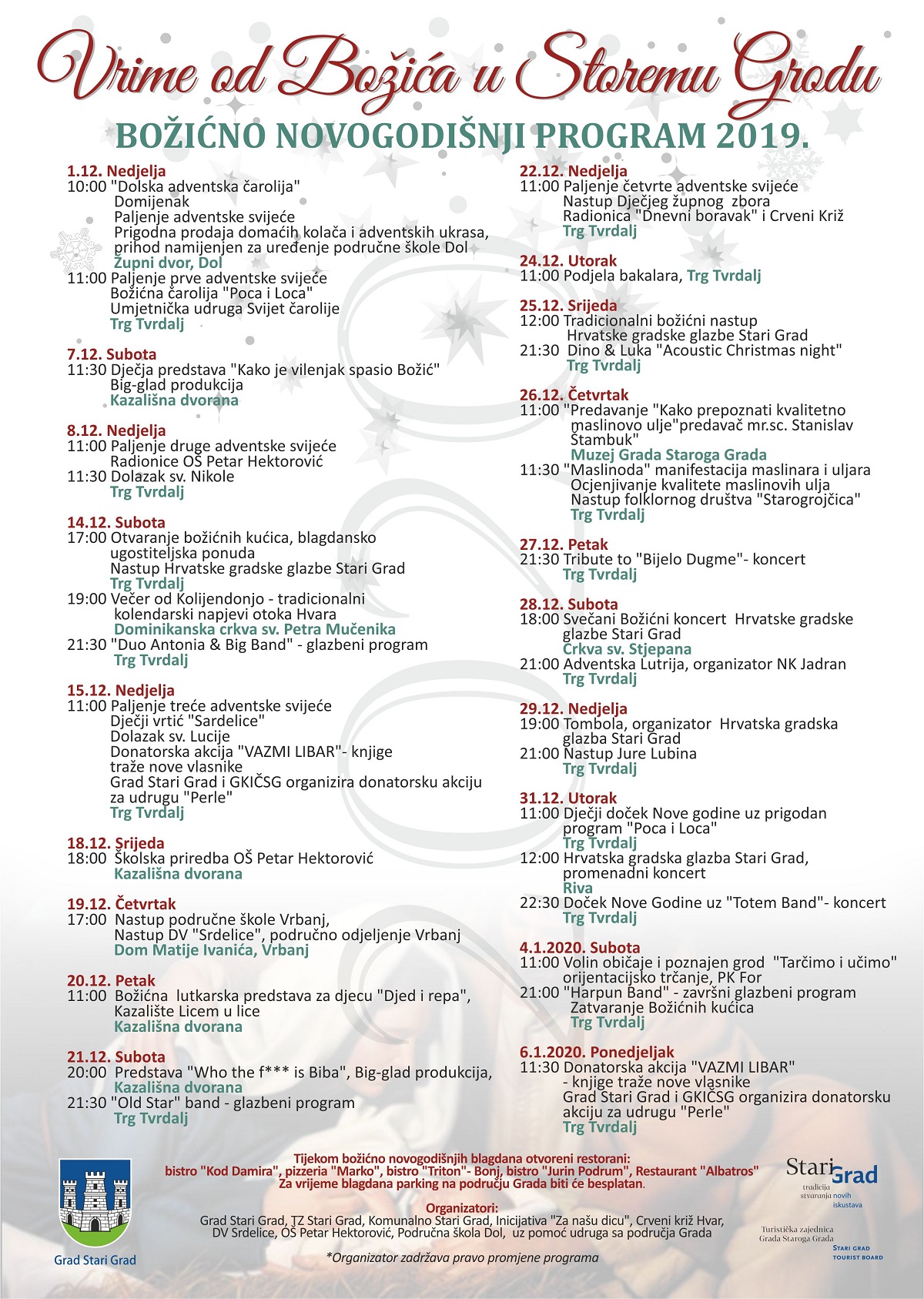
To learn more about the island of Hvar, check out the Total Croatia Hvar in a Page guide.
Meet Croatia's UNESCO World Heritage Sites: Stari Grad Plain on Hvar
November 27, 2019 - Filipa Marusic continues her look at the considerable UNESCO heritage in Croatia. Next up, World Heritage Site the Stari Grad Plain on Hvar.
The Stari Grad Plain is a cultural landscape that has remained almost the same since the Ionian Greeks came from Pharos in the 4th century BC. This heritage has been part of the UNESCO World Heritage list since 2008. It showcases the ancient geometrical system of land division used by the ancient Greeks called the “chora” which has remained intact over 24 centuries.
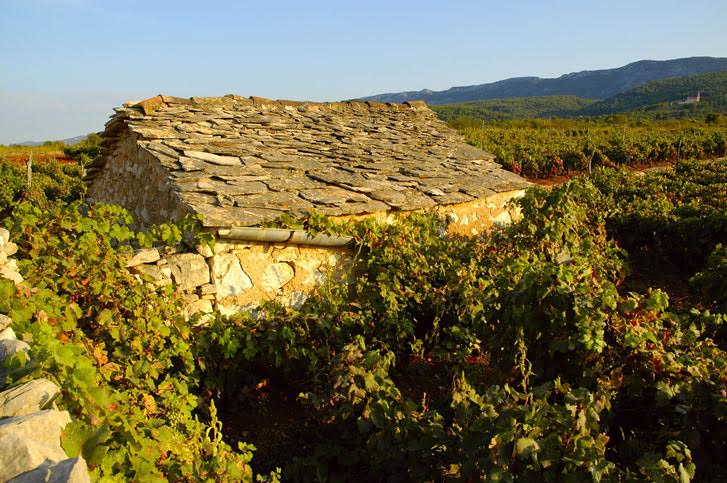
The agricultural activity in the chora was always here and based on grapes and olives the same as it was set up by the ancient Greeks 2400 years ago. The shape of the land division is the same, and the structures built by dry stone walling are authentic and reused throughout time. Additionally, this is a unique example of the land parcel system introduced by the Greeks. The cadastral division of the Stari Grad Plain is one of the best-preserved examples of Greek ancient culture in the entire Mediterranean. Despite all the historical and political changes over the centuries and multiple divisions of the plain, the Greeks set the structure. The Greek chora is embodied in the dry stone wall, which marks the land division. All later divisions of the land – Roman, medieval, or newer were always respecting the Greek shape and had the same dry stone walling technique. There is evidence of all different cultures who used the plain throughout time. The evidence is different archaeological findings dating all periods, from pre-history to medieval times.
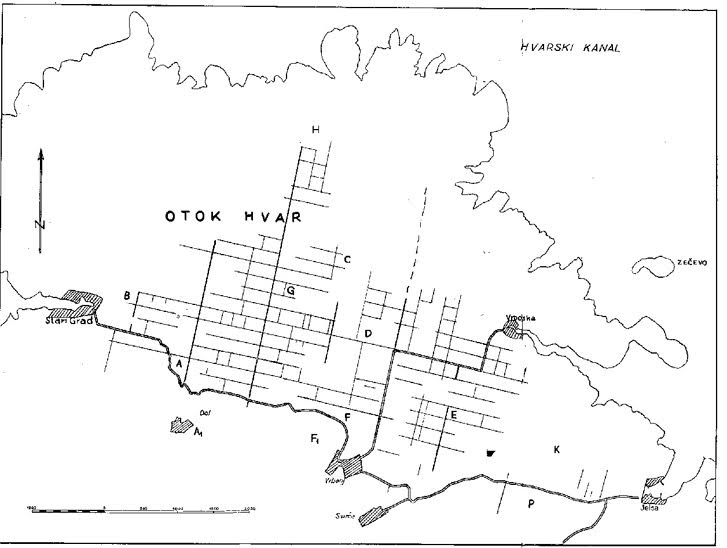
The Stari Grad Plain is the biggest and the most fertile plain on the Adriatic islands. It had and still has its agricultural use, and local people grow the same cultures – olives and grapes. Archaeological findings prove the local inhabitants had their faith in the fruitfulness of the plain. In medieval times the plain was under the protection of the patron saint of Hvar diocese St. Stephen. The Hvar statute from 1331 mentioned the plain, and it listed roads and borders of the plain and several place names for places with later discovered archaeological evidence. The Stari Grad Plain changed its names according to how its owners changed. Different names include Greek Xωpa Φapoυ, Roman Ager Pharensis, medieval Campus Sancti Stephani, or today Stari Grad Plain.
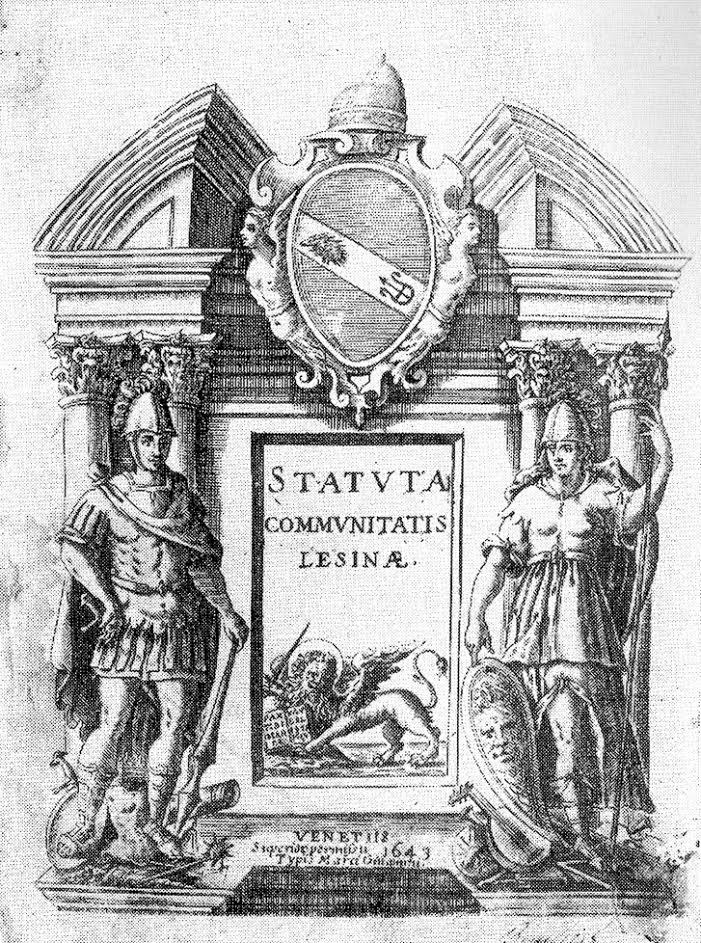
The precise boundaries set by the Greeks in the plain are the work of villagers who used dry stone walling techniques even in ancient times. Some are just a barrier between two different lands, while others are quite wide and were in use as paths. Around the plain, there are circular stone houses called “trimi” or “bunje” used in the past as storage and shelter during bad weather. While the land here is fertile, the Mediterranean climate often has dry weather, so the plain has several reservoirs for collecting and saving the rainwater. All the different buildings located in the Stari Grad Plain range from the remains of farmhouses and drystone shelters to churches and chapels are there to prove the reusability of all the elements through centuries.
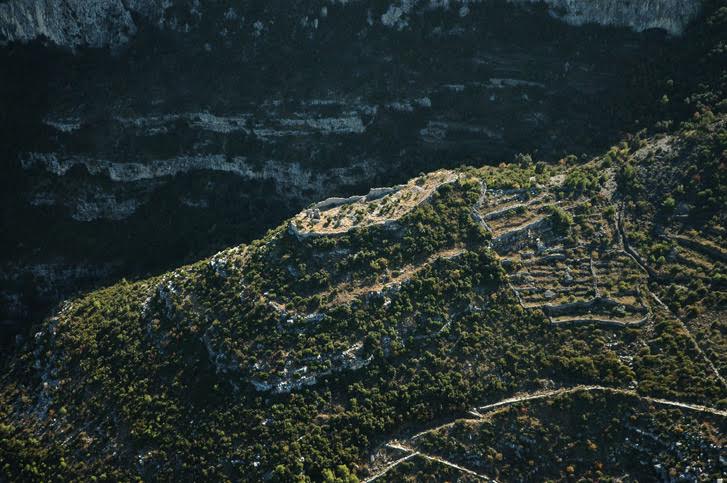
The Greek origin is visible in the very island name coming from Greek word Pharos (Faros), which ancient Greeks from Pharos island in the Aegean Sea gave when they arrived at where is now Stari Grad in 4 century BC. There were about 1000 inhabitants sent to colonise Hvar island. When Pharos became an independent Greek town polis in the 1st century BC, the Romans named the island Faria. In early medieval times, when Croatians came to the islands, they took over the names which locals used and adapted it to the Slavic language – this is how we have Hvar island name. Most Greek colonisations happened from 8th to 5th century BC, and there were about 700 colonies in the Mediterranean and Black Sea. At that time, there were just a few Greek colonies in the Adriatic Sea, so Adriatic islands were the only uncolonised part of the west from Greece in the 4th century BC.
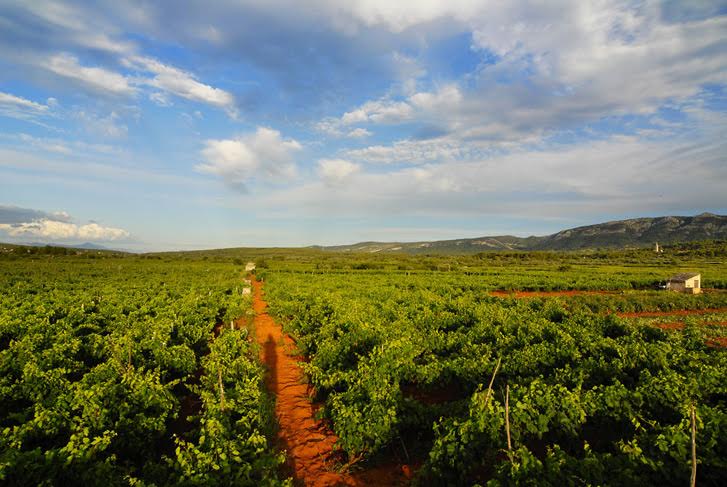
There is some prehistoric evidence dating back to Neolithic times (6000-3000 BC), which proved this fruitful area was inhabited much earlier than the Greeks. Additionally, there are findings from the Bronze and Iron Age as evidence the Greeks found native inhabitants on Hvar when they first came. Also, at the time, Illyrian tribes lived in this area, and islanders cooperated with Illyrian tribes on the mainland. When Greeks from Pharos came to Hvar, apparently, there was at first peaceful agreement with local inhabitants. Later on, this agreement wasn’t respected, so local natives decided to attack the colony. As the land division was one of the main tasks of colonisation, this was probably one of the reasons for the conflict. We also know that the Greeks built the town on the coast with fortifications. This fact, along with the land division, meant then needed a lot of money at the time to do that.
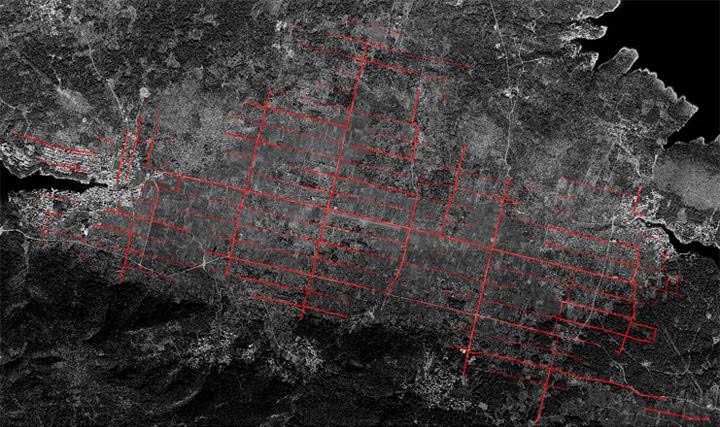
The cadastral plan and air image of the plain show that the border around the land has a size of about 180x900 m, no matter the division within this land part. The ancient Greek measuring system contains the measures that were in use. 180 m was the length of the Greek stadium while 900 m have five stadia. The average width of the roads was 10 Greek feet or about 3 meters. The Greeks used different sizes for this measure, but here research discovered it was 0,3026 m, and it was probably a standard measure in 4th century BC for some Greek towns. All the divided land in the direction east-west are parallel and break in one central point in the direction north-south. In ancient Greece, this point was called “omfalos” and represented the central unit where different paths meet. The land measure excluded the connecting roads. The base for the plain is karst terrain with several slopes where the land can quickly erode, and this is why people built so-called terraces or support walls. The terraces and dry stone walling is a valuable heritage people nurtured for years.
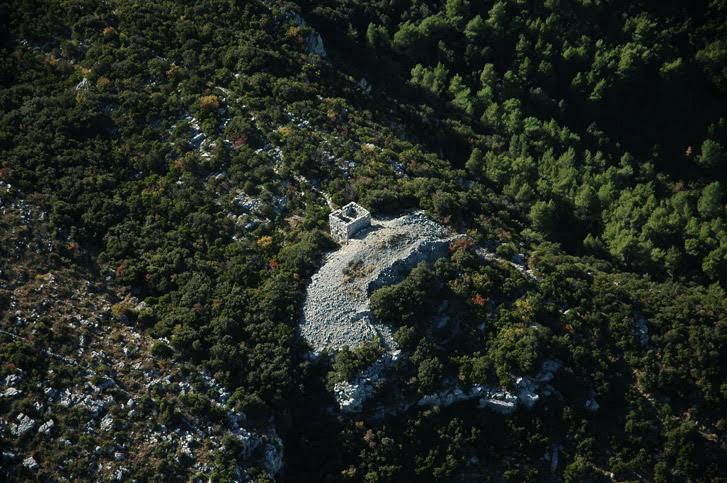
The chora had farmhouses, but there are just a few found as they were probably the foundation for Roman villa rustica. In the area, two guard towers protected the land. Additionally, there were perhaps temples dedicated to gods of fertility. There weren’t many Greek inscriptions in the area, but there is a stone fragment where it said “Border of the land of Matija, son of Piteja” which meant people of the time respected their land borders. Another larger inscription is evidence that local people of Pharos set three members to Greek Pharos to ask for money to renew the city, which proves they had a democratic setup. The local Greeks also were equal in terms of land amount and had similar housing.
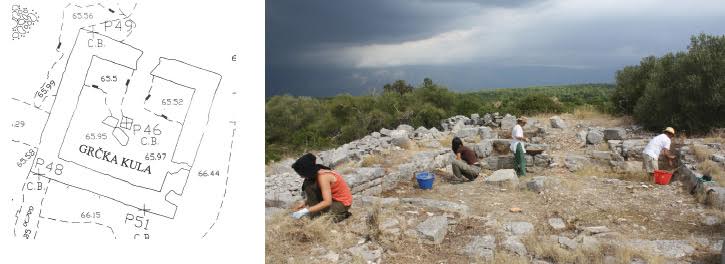
The ancient Pharos even had its mint, but as Greek Paros didn’t have their own money, they used money from Greeks on Syracuse as inspiration. There are numerous versions of money from this area, as well as coins from different regions proving there were plenty of trades going on in ancient times. The ancient vessels and vases from the area show they were imported from Greece or locally made. The end of Pharos ancient Greek town is not known, but there is evidence of Roman building activity from 1st century BC.
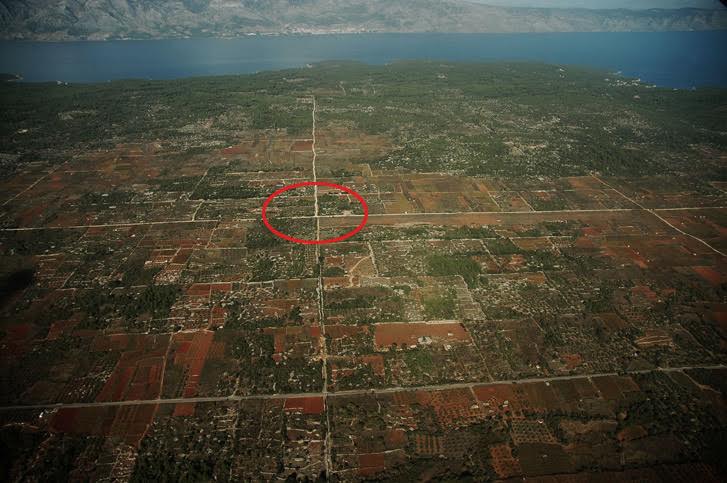
In ancient times the most important agricultural products were wheat and olives. The plain area divided this way gave good income to people – if they grew just wheat, the market surplus was between 41000 and 157000 silver drachma (one drachma was the daily income of the worker and its equivalent of approximately 30 EUR). The Greeks planted olive trees and produced wine, figs, rosehip, almonds, carob, and other cultures. They went fishing, hunting, and were beekeepers. They also had cattle for food and for towing and carrying loads. The different amphora remains proved there was active production of wines and olive oil. The ancient Greeks probably had food supplies and stored the food for the time of war and as protection against robberies.
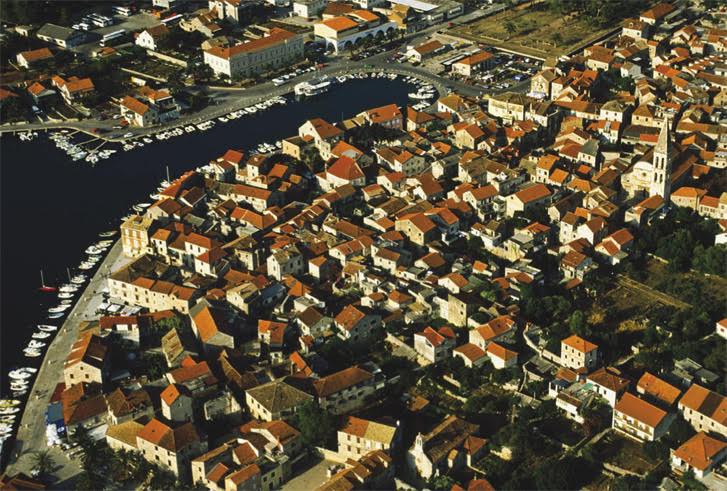
Toward the end of ancient times, Hvar island was quite well inhabited, especially the Stari Grad Plain area. As already mentioned, there are some early Christian churches which have medieval artifacts as well as circular dry stone shelter buildings from different periods. The Stari Grad itself has a range of different structures from the late ancient period to the end of the 19th century, which together create urban complex. From medieval times the bigger ancient lands were divided into smaller parts, and they reflect the changes through centuries.

When it comes to everyday life around Stari Grad plain was always connected to agricultural works depending on the season. The Hvar statute from 1331 gives the oldest written advice on agricultural work. Even today, the same rules are used in agriculture – the first warmer days after winter are for work, and this is the hardest part, and then summer is to keep the vineyard from any diseases. September is the month of harvest, followed by winemaking in October. November is olive picking, and December and January are for rest. From all the agricultural cultures, there are mostly grapes and olives but also lavender and rosemary, as well as other fruits grown here from ancient times. When some of the vineyards were destroyed at the beginning of the 20th century, lavender became part of Hvar's agricultural heritage. Rosemary is another aromatic herb growing on Hvar and other parts of the Adriatic coast. The vineyards and winemaking heritage are part of local identity for centuries. The authentic Dalmatian variety plavac mali grows here as well as indigenous Hvar variety of white wine bogdanuša and prč and red wine drnekuša. Olive trees were probably on Hvar even before the arrival of Greeks, but their arrival meant the beginning of cultivated olive groves.
The religious celebrations set the time for the biggest local festivities. At Easter time, there is a unique procession Za Križem during the night from Maundy Thursday to Good Friday, which has been the same for more than 500 years going from different villages and towns around the Stari Grad Plain. TCN wrote about this unique UNESCO protected heritage in several pieces. At Christmas time there is kolendanje – groups of children or adults sing old songs with good wishes for the year that is to come in front of the houses of friends or neighbours. The special occasions ask for special meals such as starogrojski paprenjok – a pastry made from honey, flour, olive oil, prošek and different spices. It represents local traditions and uses locally produced ingredients.
If local people didn’t use the Stari Grad Plain, the valuable heritage wouldn’t be at such a good level of preservation. The Stari Grad Plain is the best-preserved example of the Greek land division, and it stayed that way as locals continuously used the land throughout the centuries. The dry stone walls which were built and rebuilt saving the shape of the parcels. The value of the Stari Grad Plain encouraged local and state authorities to work on the revitalisation of old parts of the plain with planting traditional agricultural varieties and promoting this heritage in the cultural aspect of Hvar tourism. The idea is to keep the same shape and land parcel system set by the Greeks and keep all the paths and routes around the lands the same without the use of any modern building techniques. The idea is to renovate all the buildings according to the traditional way and reuse them for tourism purposes and keep archaeological researches active.
For more information about the Stari Grad Plain, visit the official website.
To learn more about Stari Grad, here are 25 things to know.
Forska Liga: Hvar Has World's Most Football Clubs Per Capita (and a Great League!)
November 22, 2019 - It has a football club for every 1108 inhabitants, a highly competitive league, and a football tradition dating back to 1913. Meet football on Hvar and the Forska Liga.
1911 is an important date in the history of Croatian football. For it was in this year that a few Croatian students in Prague went for a few beers in a pub called U Fleku and decided to form their own football club.
And so Hajduk Split, easily the most famous Croatian football club (and a club with arguably the most fascinating history in the world) was born.
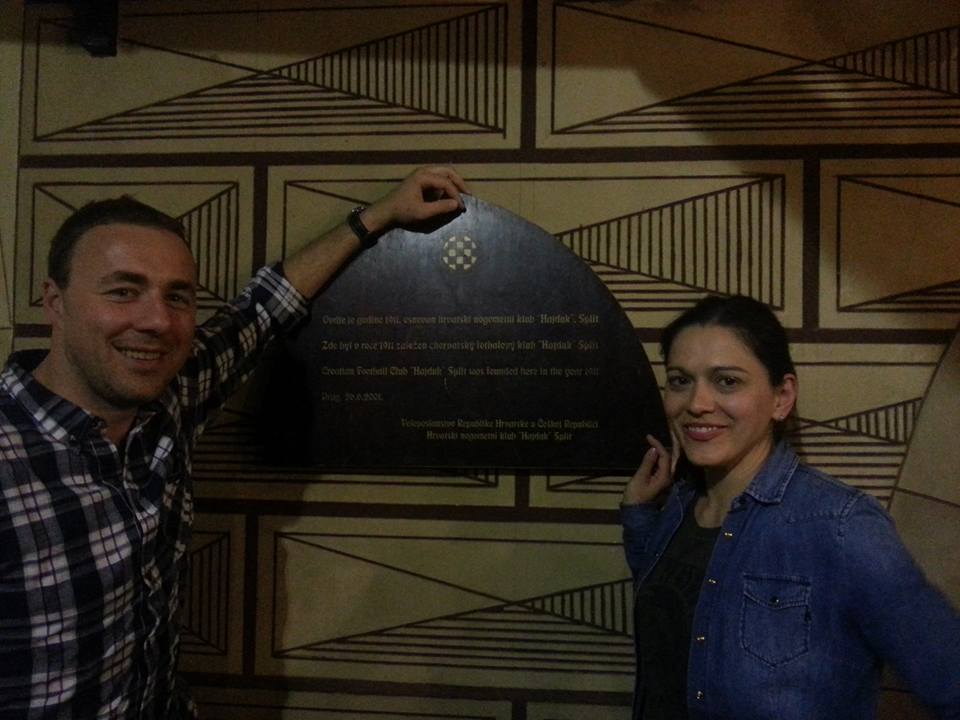
The club - and the pub - still exist today, and a plaque commemorating the event still exists today. It has become a must-visit for all Hajduk fans, and I am very grateful to former Croatian National Tourism Board director in Prague, Jelena Bilic, and her lovely new husband (congratulations!) for taking me on the pilgrimage back in 2016.
But a date which is not quite as widely celebrated was two years later, 1913, for that was the year that the football tradition on the island of Hvar began with the founding of two clubs in Stari Grad, Balkan and Nois. A tradition which would take root to such an extent that a century later, as Hajduk spectacularly celebrated 100 years of existence (see the incredible scenes from Split in the video below), Hvar was also able to claim something incredible - not only a fully functioning island league called Forska Liga (For is the dialect word for Hvar), but the biggest number of football teams per capita in the world. An amazing one football team for 1100 people according to the 2011 census.
The Forska Liga did not start until 1969, having been made possible with the new road to Sucuraj, but there was an incredible number of football teams on such a small island before that, as this table from Island Hvar Info shows.
Five clubs from the village of Brusje in 1921 alone! Incredible.
The culture of competitive football on Dalmatian islands grew, and there was a competition in 1963/4 season which finished like this:
1. Hajduk Vela Luka
2. Omladinac Lastovo
3. Hvar
4. Brodograditelj Korčula
5. Zmaj Blato
6. Jadran Smokvica
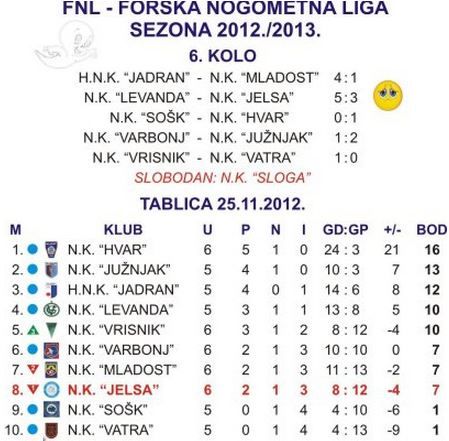
These days, and particularly after the Homeland War when the Forska Liga restarted, things were much more organised. I don't know how many island leagues there are in the world, but I suspect not many. The Forska Liga takes place during the winter months, after the grape harvest and before Easter. There are currently ten clubs, who play each other home and away. Apart from the football, this is a very social event which brings islanders together during the long winter.
And the footballers' wives play their part too. I have one such friend, who told me that the wives have the 'honour' of taking it in turns to wash the muddy football strips after every game.
When I started Total Hvar several years ago, I used to follow the Forska Liga quite closely and would always publish the results and table as soon as possible to get ahead of the other local portal. You can keep up with the latest on the Forska Liga on this dedicated Hajduk forum.
The Total Hvar coverage was not the only interest in the Forska Liga at that time. The 2011 season even had its own documentary, as Hvar TV followed the story of NK Levanda from Velo Grablje, a village with a population of just 5, but with its own football team (players came from Hvar and Split with family connections to Velo Grablje). Incredibly, Levanda won the league, the perfect end to the story of the documentary, the trailer of which you can see above.
The 2011 census recorded a population of 10,948 on the island. This means that there is a football club for every 1100 inhabitants, which is surely the densest population in the world. And indeed, the number was even lower, as two teams from Pitve and Sveta Nedjelja stopped playing in recent years. Current teams are:
“Hvar” from Hvar Town, “Jadran” from Stari Grad, “Sloga” from Dol, “Jelsa” from Jelsa, “Varbonj” from Vrbanj, “SOŠK” from Svirče, “Levanda” from Velo Grablje, “Vatra” from Poljica, “Vrisnik” from Vrisnik, and “Mladost” from Sućuraj.
The oldest team still playing is Jelsa, which has changed its name a few times since its founding in 1921. But that means that 100 years of Jelsa football tradition will be marked in 2021 - how will that be celebrated?
Amazing stuff, but did you also know that this very sporting island also had its own women's football league as well. The Hvar women's 5-a-side league ran from 2003-2010, and had an impressive 11 teams at its peak. Learn more here.
To learn more about the amazing island of Hvar, check out the Total Croatia Hvar in a Page guide.
Brac, Hvar and Korcula to Formulate Strategies for Transition to Clean Energy
November 20, 2019 - Brac, Hvar, and Korcula are currently in the process of developing a clean energy transition strategy.
Splitski Dnevnik reports that six European islands announced their clean energy transition strategies, making a significant step towards decarbonizing their energy systems with a strong focus on citizen engagement.
Six transition strategies to clean energy have already been announced as part of the program of the 4th Island Clean Energy Forum for the EU Islands, in Split and Hvar, where EU island community stakeholders meet from November 20 to 22 to discuss transitions, technologies, and opportunities for the active involvement of citizens in the European islands.
In the last 9 months, the following island communities actively developed Clean Energy Transition Strategies with a strong emphasis on the importance of involving all relevant stakeholders and putting citizens at the center of the transition: the Aran Islands (Ireland), the Cres-Lošinj Archipelago (Croatia), Culatra (Portugal), La Palma (Spain), Salina (Italy) and Sifnos (Greece).
• The Cres-Lošinj archipelago aims to decarbonize its energy system by 2040 completely. This will be partially achieved by local community-owned solar power plants.
• Culatra will work on 100% renewable energy owned by the local community.
• The Aran Islands will install community-owned wind farms, remodel homes and install heat pumps or other renewable energy sources for domestic hot water and space heating
• Salina aims to increase public awareness of energy and the environment. Salina will decarbonize its power generation plants, switch to 100% electrical/hybrid mobility on the island, increase efficiency in buildings, and decarbonize its maritime traffic.
• La Palma aims at full decarbonization and self-sufficiency in the energy sector. The island transition team is strongly focused on building a strong island energy system, actively including more than 100 local associations committed to supporting island transition.
• Sifnos wants to become 100% renewable and self-sufficient and has developed several different routes that the island could follow to achieve this goal. All plants will be co-owned by the local community and private investors.
"Thanks to the evolution of technology, the potential to reduce energy costs on the islands and the transition to energy independence has never been greater. In the context of the clean energy package for all Europeans, an essential Clean Energy Initiative for the EU islands is aimed at assisting and accelerating the transition process. Moreover, islands can be beacons for global climate action.
Whether it be the use of wind energy, the renovation of houses and buildings, the use of electric vehicles, the decarbonisation of maritime traffic or the use of renewable energy for hot water and heating, the decarbonisation solutions presented on these six pilot islands will drive them towards greater energy efficiency, the use of more renewable energy sources and low-carbon development routes,” says Ditte Juul-Jørgensen.
Energy transition strategies have been developed by island energy transition teams with the expert and advisory support of the EU's Clean Energy Secretariat. The readiness of these strategies will, in the coming months, guide the development of projects and strengthen local strategic frameworks that enhance the engagement and involvement of the local community. Additionally, they are currently in the process of developing a clean energy transition strategy for twenty other EU islands that will be published in the coming year, of which we highlight Brac, Hvar, and Korcula from Croatia.
Until now, island forums for clean energy have been held in different countries of the European Union - Greece, Spain, Sweden, and Croatia, namely Split and Hvar, has been selected as the fourth island forum.
Participation in the Forum in Croatia was confirmed by all levels of institutions, local and regional self-government units, ministry representatives, members of the European Commission and various other stakeholders from all over Europe. However, it is equally important that the Forum will be joined by representatives of more than 20 European islands in the process of transitioning to clean energy. The aim of the forum is to network island stakeholders from all over Europe and to foster dialogue with representatives of all decision-making levels in order to create a common vision for the transition of islands and to lay the foundations for its future realization.
On the first day of the conference, which will be held at the Le Meridien Lav Hotel, we will have opportunities to hear about the future of island policies from representatives from different EU and national institutions to create a common framework for further development. Considering that one of the activities during the Croatian Presidency of the European Commission is the creation of a long-term strategy for the further development of the EU islands, the panelists will present, through a moderated discussion, how the European islands will be provided with future support for their transition to clean energy.
During the second day, which will be held at the Hotel Amfora in Hvar, participants will have the opportunity to exchange experiences, learn about different technologies, but also learn about different models of islanders' involvement in energy transition investment projects. Leaders of energy transitions on the islands of Hvar, Brac, and Korcula will also present their views on the transition to clean energy.
To read more about lifestyle in Croatia, follow TCN's dedicated page.
CN Traveler: Hvar Best European Island, Hotel Amfora One of Best Resorts
The respected travel portal Condé Nast Traveler rarely has a bad word to say about Croatia, and they've kept this trend going with praise being showered over the gorgeous island of Hvar, known since long as Croatia's premier island.
As Novac/Jozo Vrdoljak/Privredni.hr writes on the 7th of November, 2019, leading world travel magazine Condé Nast Traveler has published the results of the Readers' Choice Awards and has given the Amfora Hvar Hotel the prestigious title of one of the top thirty resorts in all of Europe.
Hotel Amfora is situated in a quiet bay near the very centre of Hvar with unobstructed views of the nearby Pakleni islands, making it a unique resort on the island of Hvar. Recognised for its spectacular cascade pool and diverse offer, it is an ideal choice for couples, families and business meetings, conferences, conferences and exclusive events alike. The hotel doesn't limit itself, there's something for everyone and CN Traveler has recognised this quite clearly.
"To be in such a levied group is a testament to the year-round impeccable work and service delivery which is done to the very highest standards in tourism. It's a great honour to know that the hotel's guests recognised that and voted for us at this year's Readers' Choice Awards,'' said the hotel's director, Igor Tabak.
More than 600,000 readers around the world participated in the selection of the best of the best, which was carried out by the publication through various categories.
The best hotels and resorts, airlines, villas, spas, airports, cruisers and tour operators, cities and islands were all selected. In addition to the recognition of Hvar's Amfora Hotel in the Top 30 Resorts in Europe category, Hvar island itself was named the Best Island in Europe in 2019.
Make sure to follow our dedicated travel page for much more about Croatian tourism and the array of things this country has to offer its visitors.
Natural Stress Relief: the Olive Harvest in Dalmatia
November 3, 2019 - Every Dalmatian has one eye on the olive grove in early November - and British sons-in-law are no exception. The natural stress relief of the olive harvest.
There are few finer things in life to be than a Dalmatinski Zet, or Dalmatian son-in-law. I have a legendary Punica, mother-in-law who takes great care of me as well as my wife and kids, and a hard-working father-in-law, or Punac, whose produce from the field has restored my faith in the quality of food after being raised on the fruit and veg of the supermarkets.
My Punac has long ago given up on the hope that his British zet would be a man of the soil such as he is, and no demands are made of me, but there is one time of year that I try my very hardest to be available with the family - the olive harvest.
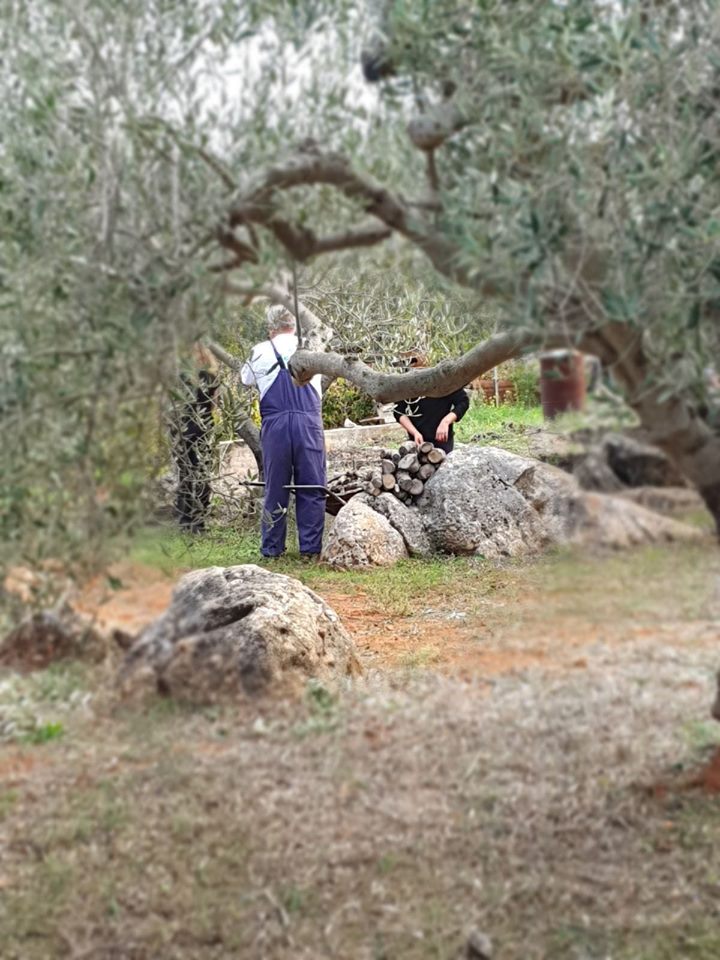
(Photo Taliah Bradbury)
In addition to all the other fresh goodness that comes daily from the family field, my Punac's 80 olive trees provide the family with enough of this precious Mediterranean liquid gold to supply the family for the entire year, and often longer. When all four kids lived at home, cheap labour was abundant for the annual pick of in excess of two tons of olives a year.
But as the kids flew the nest to university and then jobs and families elsewhere, the olive harvest became a little harder to coordinate in terms of assembling the workforce. All the kids have the harvest in mind, even if they cannot be there themselves. It is a trait I noticed in Dalmatians in Zagreb years ago - late Autumn meant olives, and successful business executives would head to the coast and islands and put on their work overalls to be at one with their olives. It is a serene atmosphere, and my daughter caught a little of the atmosphere in the video above (when she should have been picking...).
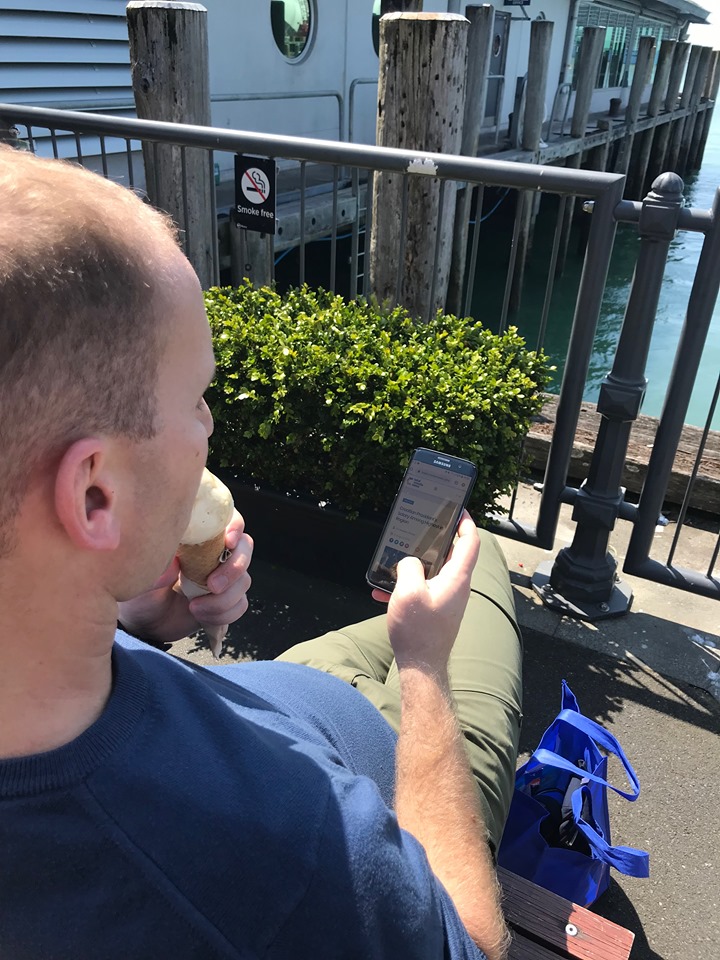
Three of the four siblings made it to the field for this year's harvest, with the other trying to claim he was with us in spirit by sending a photo of him sitting eating an ice cream on the water in New Zealand while reading Total Croatia News.
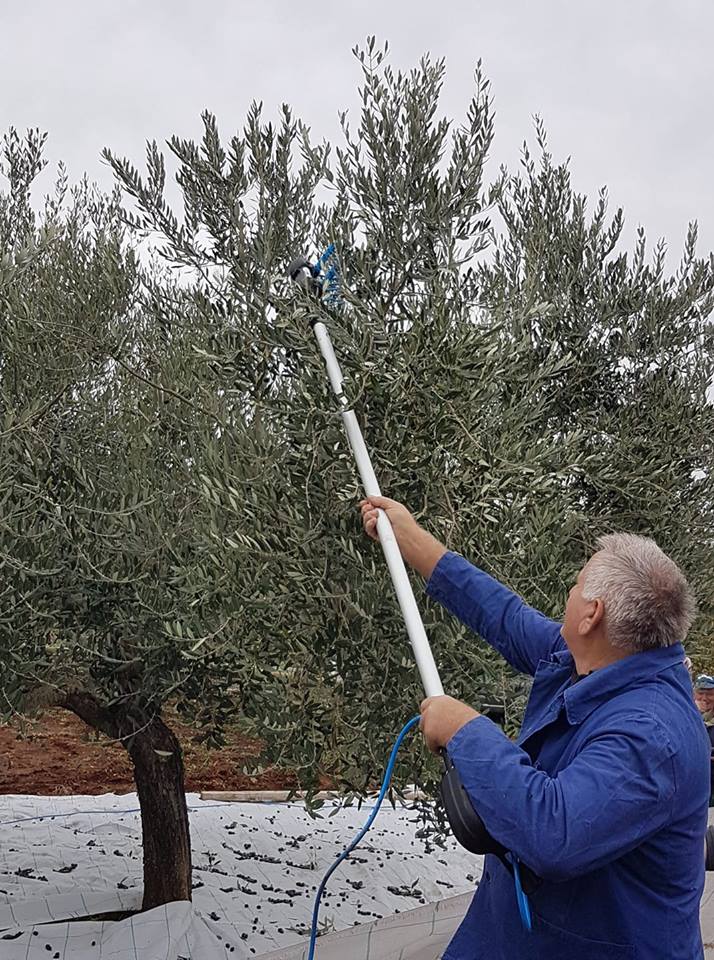
And so to work. With a less reliable pool of workers than previously, there was a major change to the olive picking lineup last olive harvest, as my Punac introduced a machine to replace the previous hand-picking 'technology' which had ruled for generations. The two-pronged machine shook the branches gently, encouraging the olives to drop to the sheet on the ground.
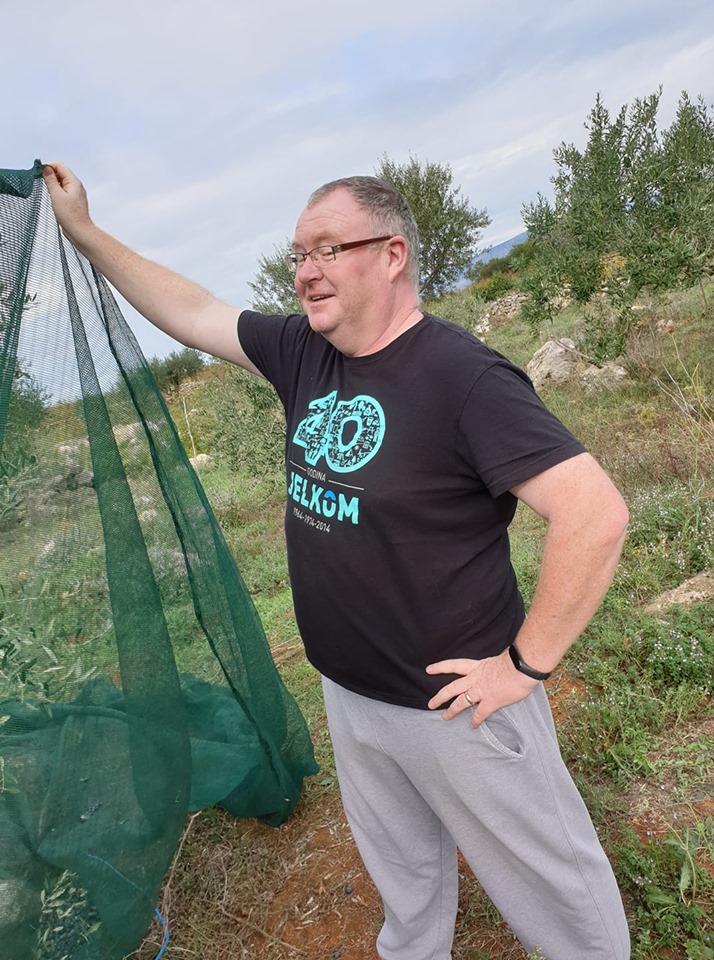
Maybe it is not a technique for the purists, but it is very effective. Not all olives drop to the ground, of course, and an important component of the support workers is to hold the net high. This is as much as act of self-preservations against flying olives hurtling to your face as an attempt to capture all of the olives. Do some olives escape the net? Absolutely. Is the picking time considerably reduced? In a way you wouldn't believe. What had been previously up to 2 weeks of picking was reduced to over two tons of olives in just over 3.5 days in early November sunshine. Final olive oil litre count is expected to be about 250 litres, more than acceptable.
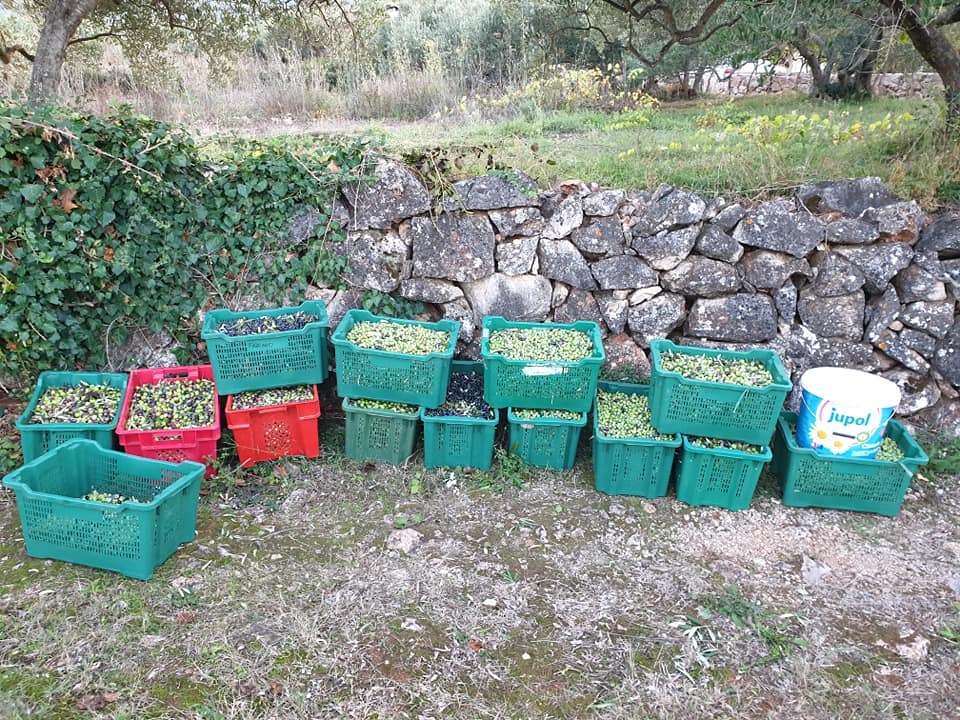
Here is the bulk of the day's olive harvest - we managed about 20 crates a day.
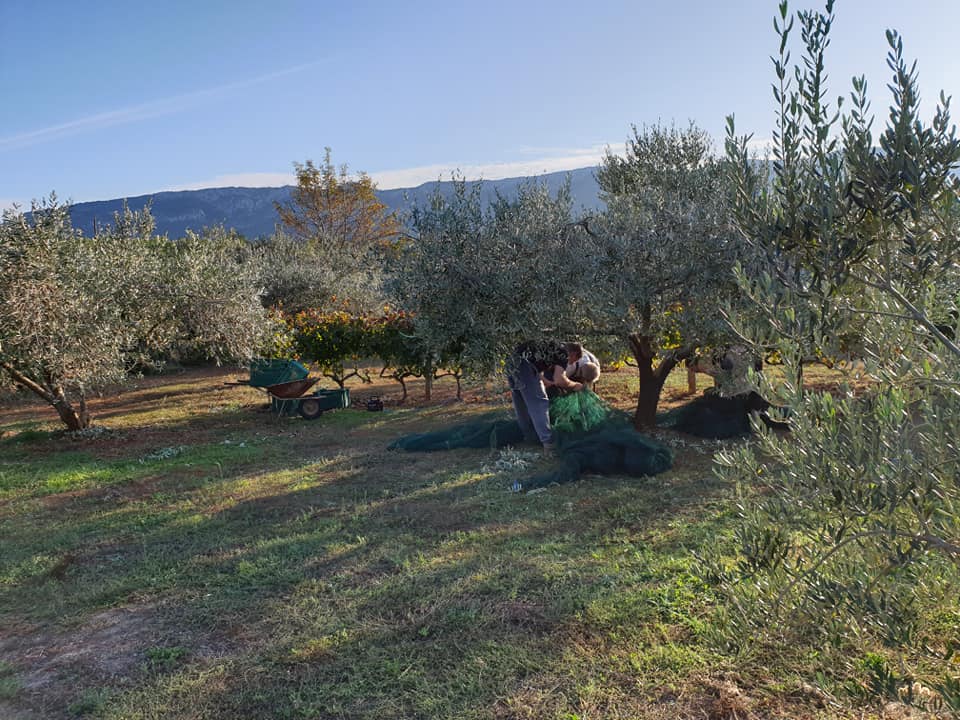
Peace. Tranquillity. Nature. Whatever your stresses elsewhere, you can leave them behind in the field. And the hand-picking technique is still required for trees which are less productive, as close to Nature as you can get.
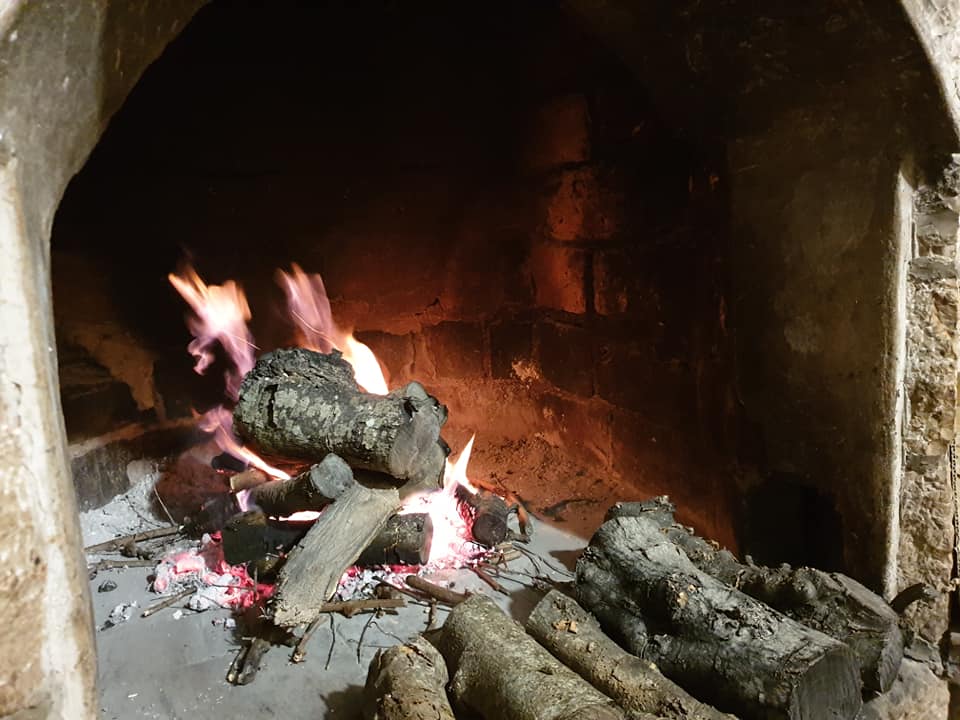
The highlight of any olive harvest, apart from picking that final olive, comes at the end of the day - rostilj! the grill!
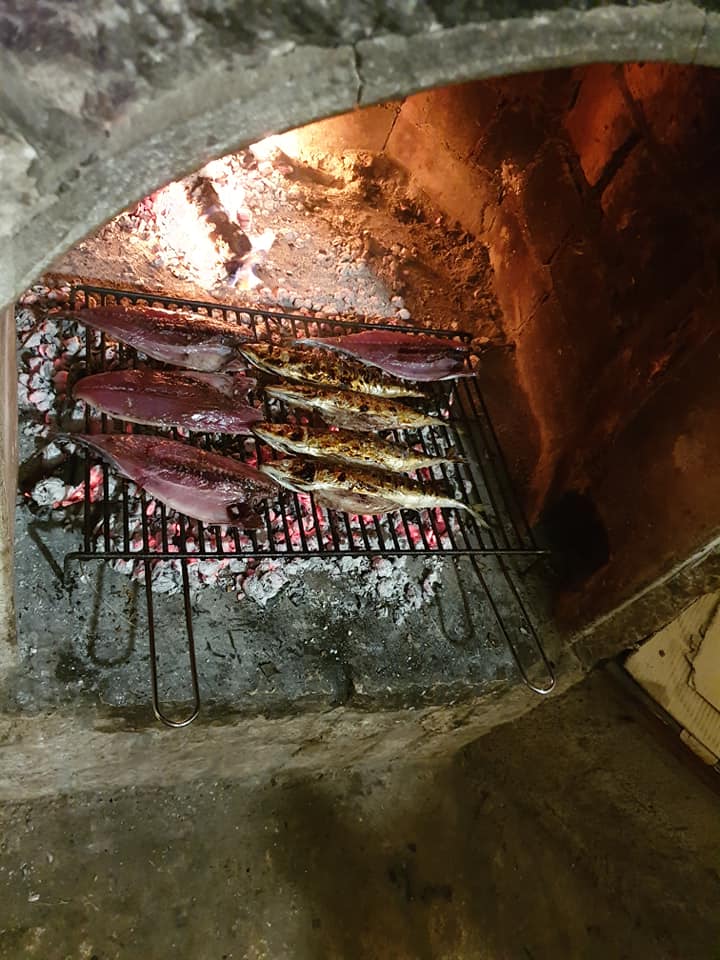
The quality of an olive harvest lives long in the memory when measured by the quality of the feast which follows, and in this regard, my Punac never disappoints.
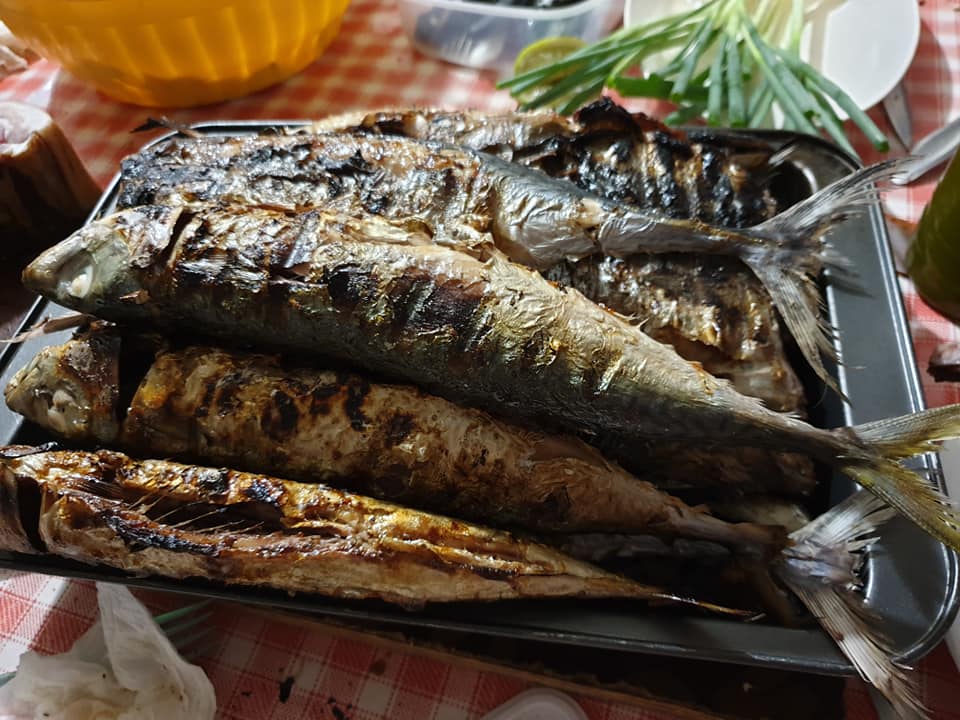
An impressive seven kilos of fresh fish, with additional sardines, were served up with salad and wine from ingredients in the field. The simple Dalmatian lifestyle at its very finest.
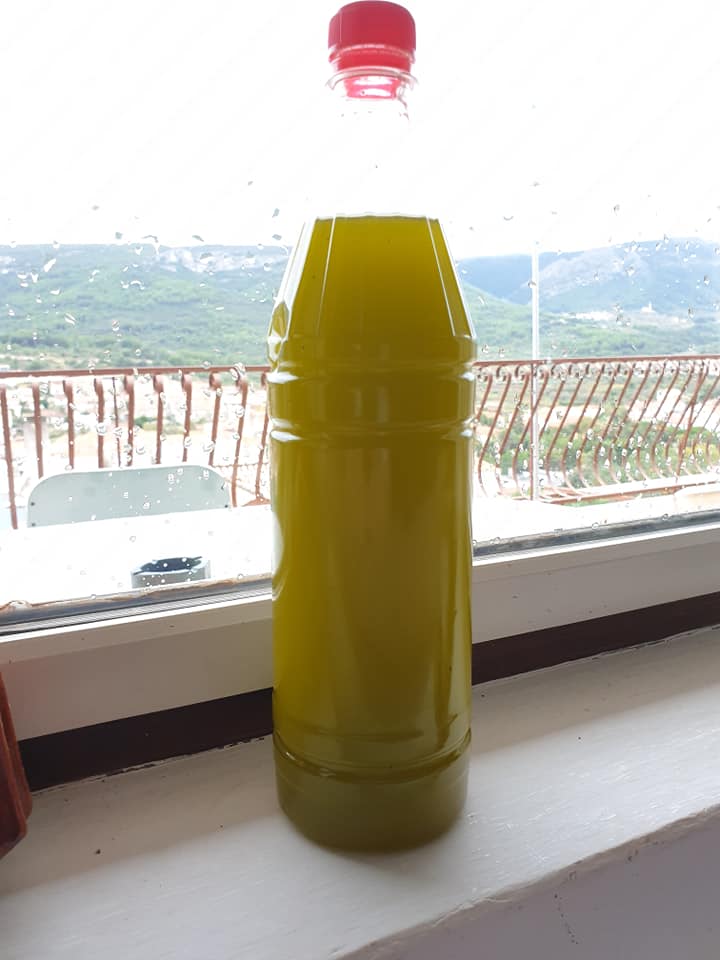
The job complete, thoughts of a return to home to our regular lives. A division of oil for the parting family, and a sigh of relief that the olive harvest timing had been so perfect. Our 3.5 days of picking in the sun were replaced with rain the following morning.
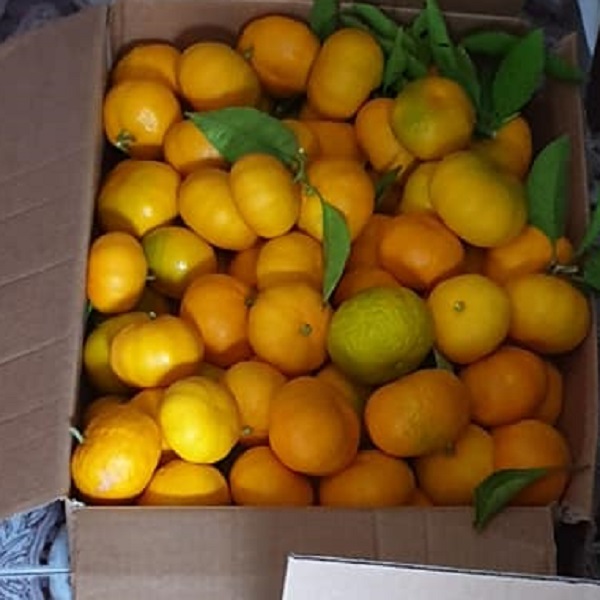
And why limit yourself to the olive grove, when there is so much goodness in the family field? Boxes and boxes of mandarins were filled from the family trees, destination Zagreb and Varazdin.
And so it came, the end of another olive harvest, and the ferry back to Split and onwards north. Thank you dear Punac and Punica, you are the best. Will see you in November 2020 in my finest olive picking attire.
Lesina to Lesina 2019: Connecting Hvar to Italy by Kayak
October 26, 2019 - Hvar adventure tourism takes to the open seas, as Hvar and Italy are connected by kayak in Lesina 2 Lesina 2019.
I have a good friend from Hvar called Vese. She is an adrenaline freak and is always up to something crazy. Now the owner of the successful And Adventure active tourism agency, she was one of the pioneers of adventure tourism on Hvar with the first such agency back in 2005.
Just following her on Facebook made me feel a lot healthier, and her guys were always up to something crazy.
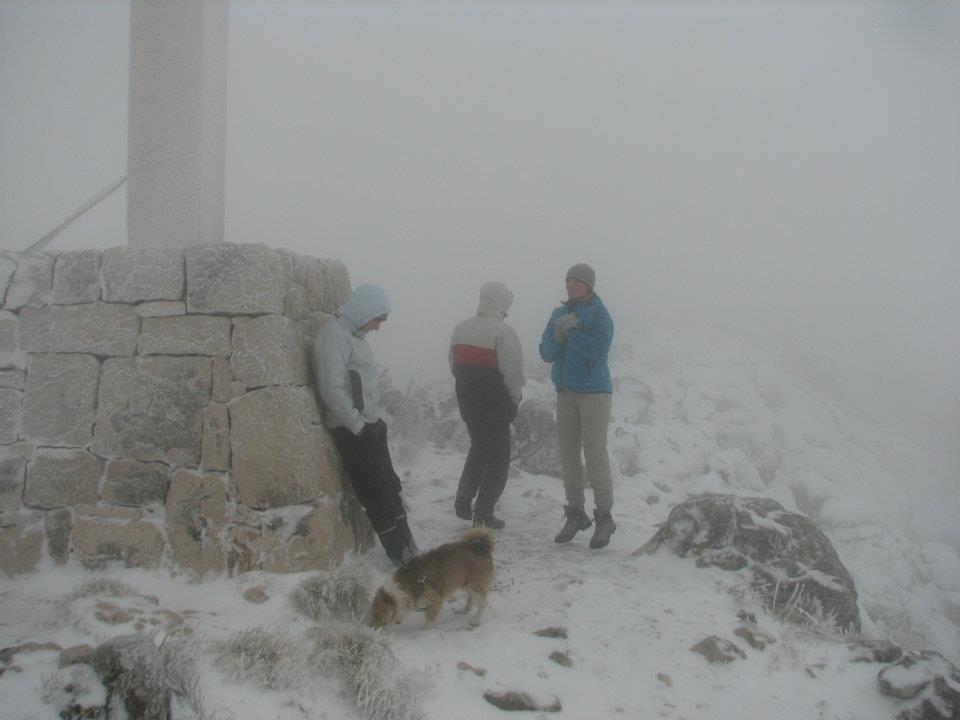
Such as time we all awoke on February 4, 2012 to find the entire island of Hvar covered in snow. While most sensible people stayed inside, those guys decided to jog on up to Sveti Nikola, the peak of the island.
So when I heard of a project to connect Hvar (whose former name was Lesina in Venetian times) with Lesina in Italy, I had a feeling that Vese's agency might be involved. And so it proved - here are details of the planned trip as previously featured on TCN).
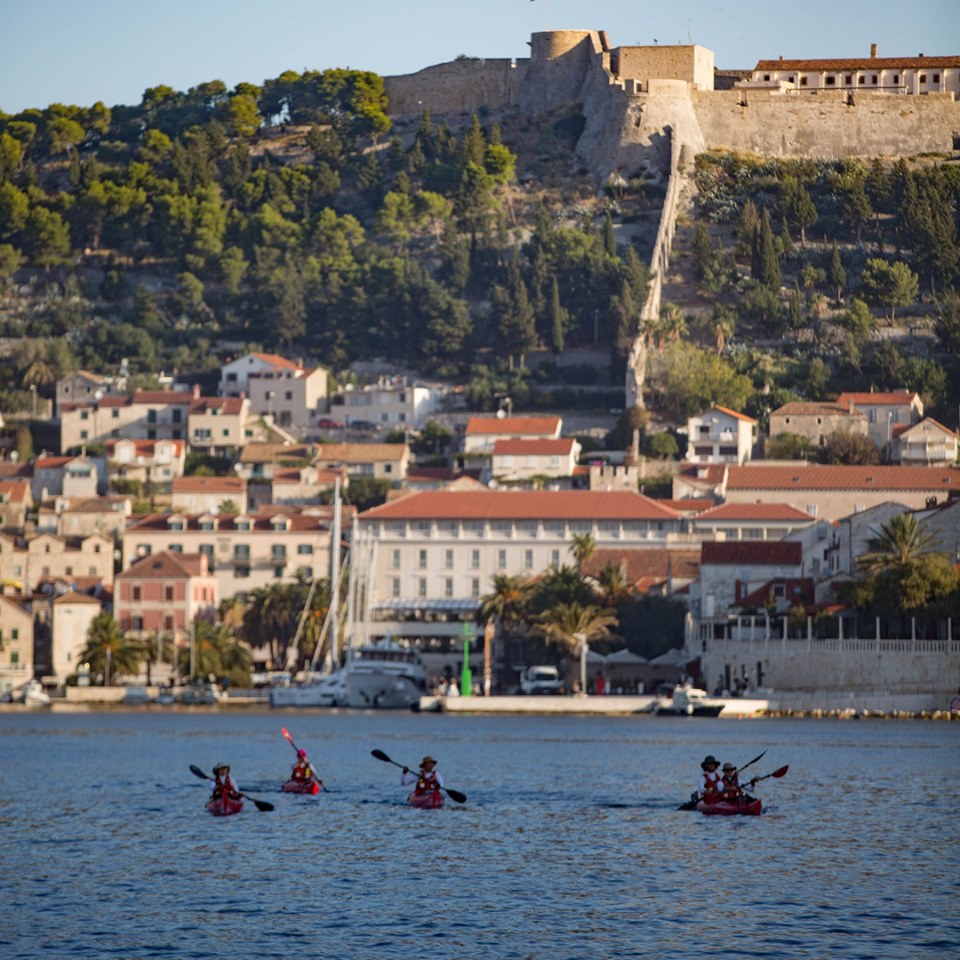
It was always going to be a challenging trip, even in perfect weather conditions, something hard to guarantee in mid-October, and the trip certainly started brightly enough from Hvar Town, above.
The Lesina 2 Lesina team posted a daily update of their progress, which I will reproduce below:
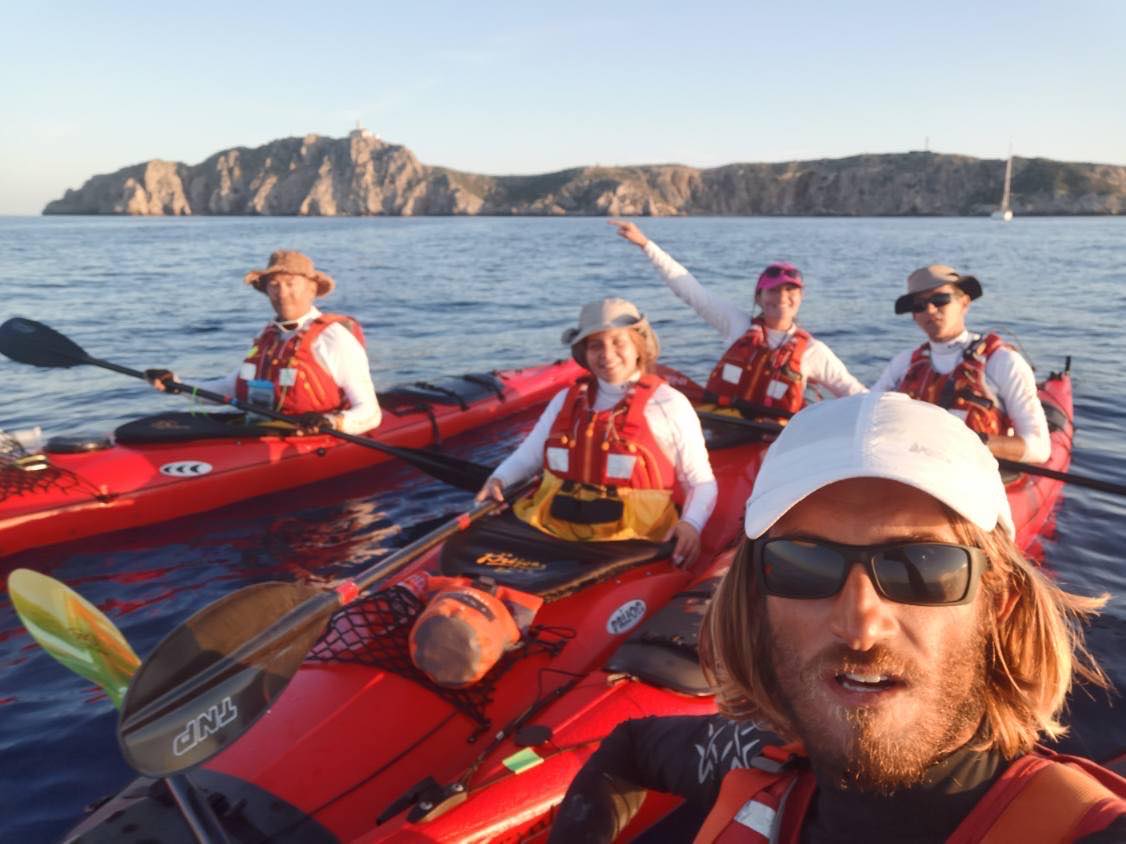
DAY 1:
We started on Tuesday 15th of October at 8am from Hvar! Weather was good but all the time jugo was increasing so we had to cut the day a bit shorter than planned! We paddled 15Nm all the way to Proizd (near Vela Luka) where we left kayaks and continued on a support boat to Vela Luka for overnight. Successful day!
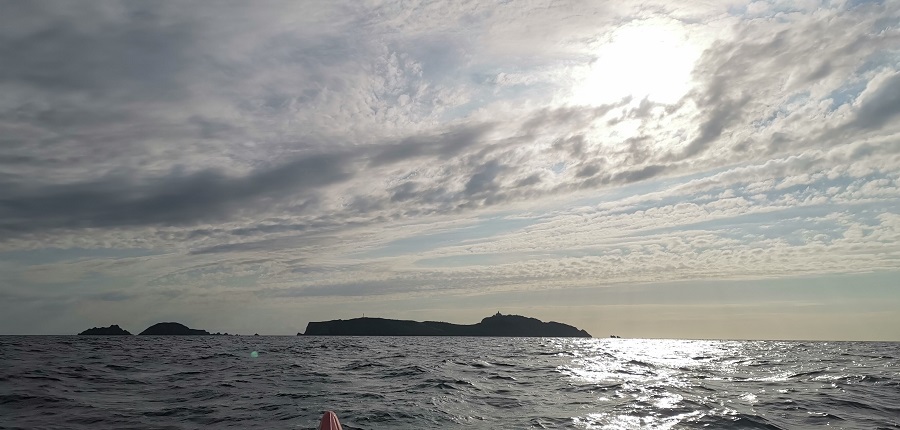
DAY 2:
Second day jugo increased too much for safe kayaking and there was no option for safe mooring for the support boat so we had a hard time to bring a decision to stop kayaking. Final call was to sail to Ubli in Lastovo and spend a night there and the next day get to Sušac. We had to move forward with no delays as the weather forecast was showing changes in upcoming days!
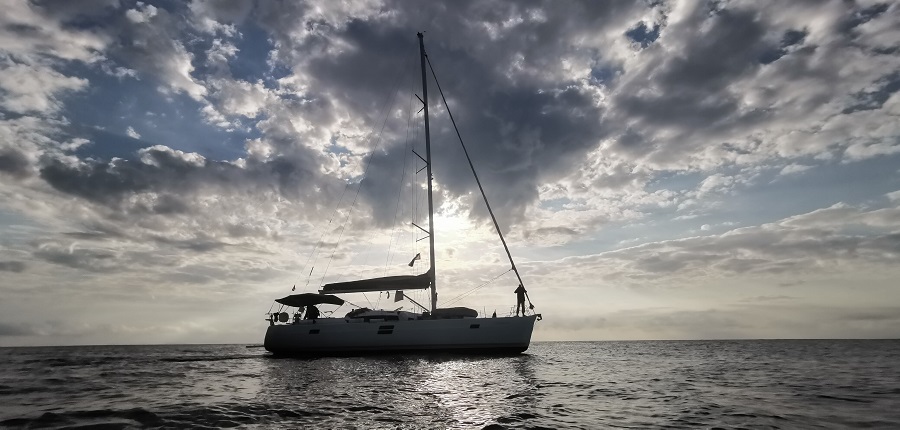
DAY 3:
Our skipper started from Ubli around 5am and we were at Sušac ready for what we thought was the longest day! We started paddling from Sušac to Palagruža, about 25Nm and about 7,5 hours. Struggling with waves, some winds but at least it was in a favourable direction. We arrived at Palagruža just before sunset! Perfect time to witness how magnificent it is.. as it is from different world! We found a safe mooring spot for overnight, got in the boat as we had to make plan what to do next... Looking at the weather and keeping on mind safe mooring spots for our support boat we have decided to alter the original plan!
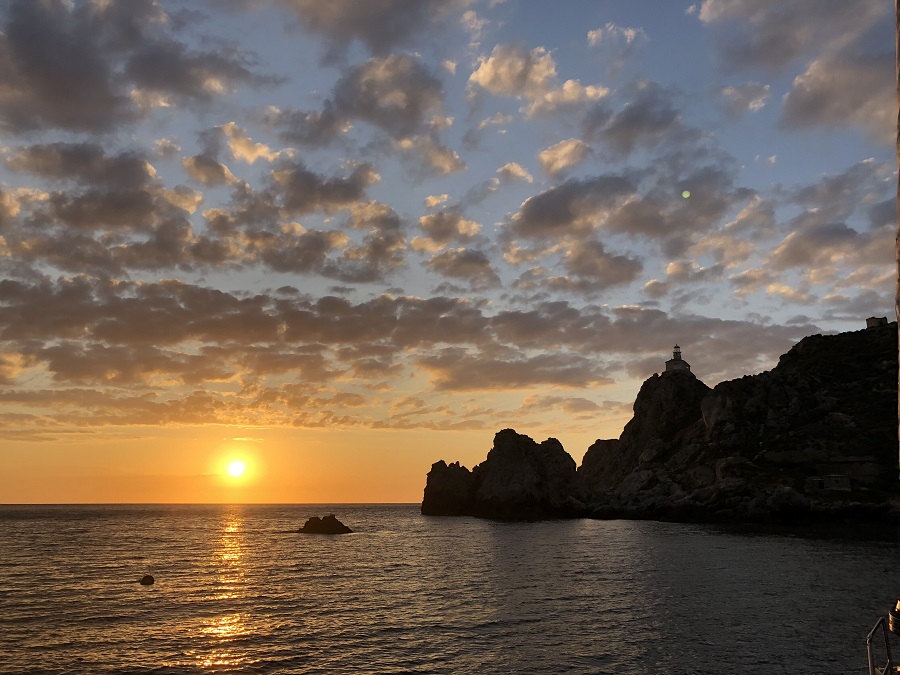
DAY 4:
This was the longest day! As we had to rush to make sure the weather will still be favorable for our return we decided to cut a day, but that meant that we will skip visiting Lesina. So instead of adding one more night on Tremiti islands (about 23Nm to Pianosa) we have decided to go for 31Nm to Vieste. This was also the most beautiful day! Calm, almost no winds until we came closer to Italy and jugo started to pick up. About 10 hours of the open sea until we finally reached Vieste and connected Hvar with Italy!!
Truly a wonderful journey!
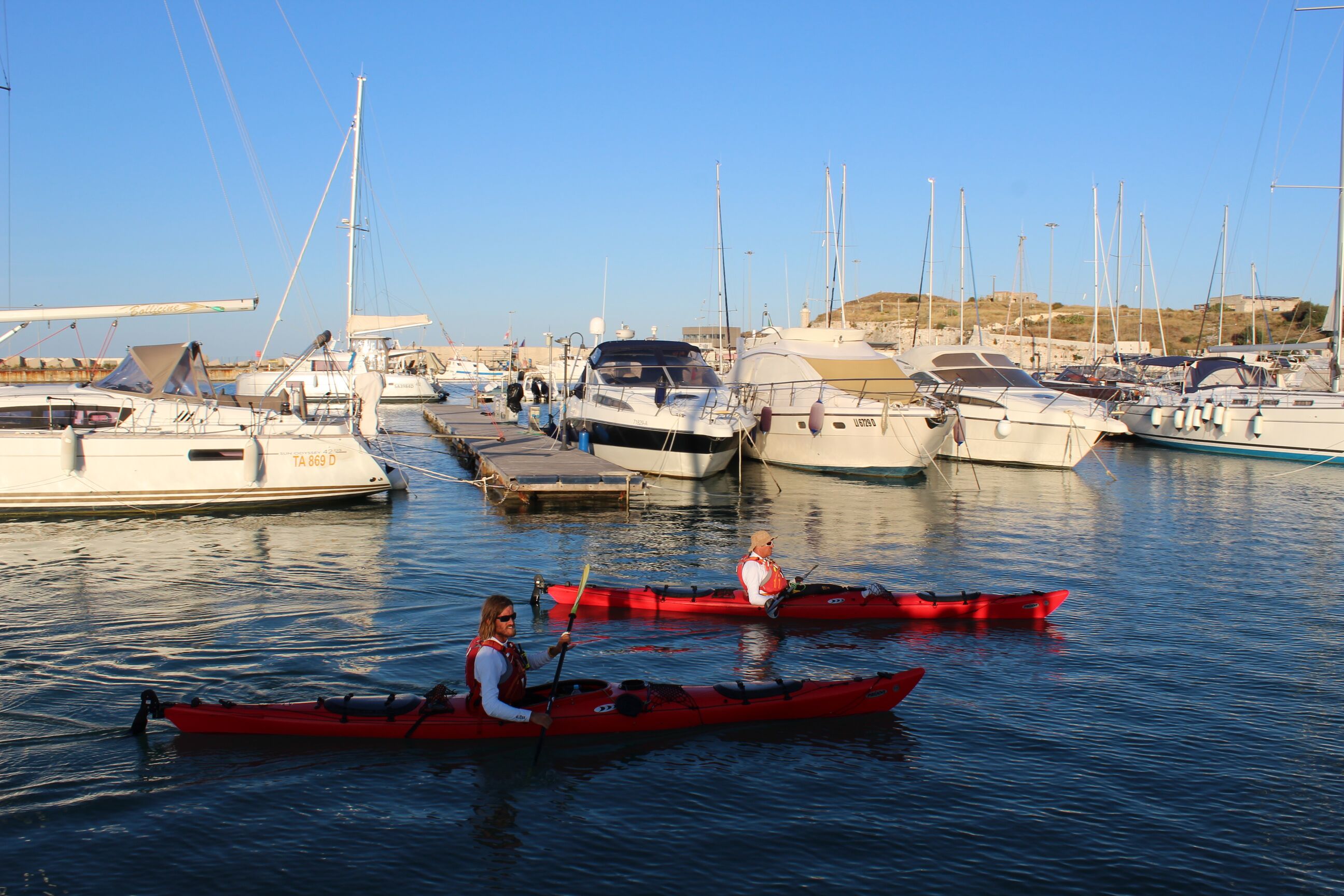
Participants: andAdventure sea kayaking team: Kristian Marovic, Vedran Medvesek, Veselka Huljic, Anamaria Šparica and Georges Buj from TZ Hvar + AndAdventure support crew on the sailing boat: Capitan Goran Treursic, his beautiful daughter, Tina Treursic, who was making sure our stomach is full and happy, young skipper Filip Biočina.
Sponsors: Visit Hvar, Grad Hvar / Hvar Town, Visit Jelsa, Visit Stari Grad Hvar and Hula Hula Hvar official.
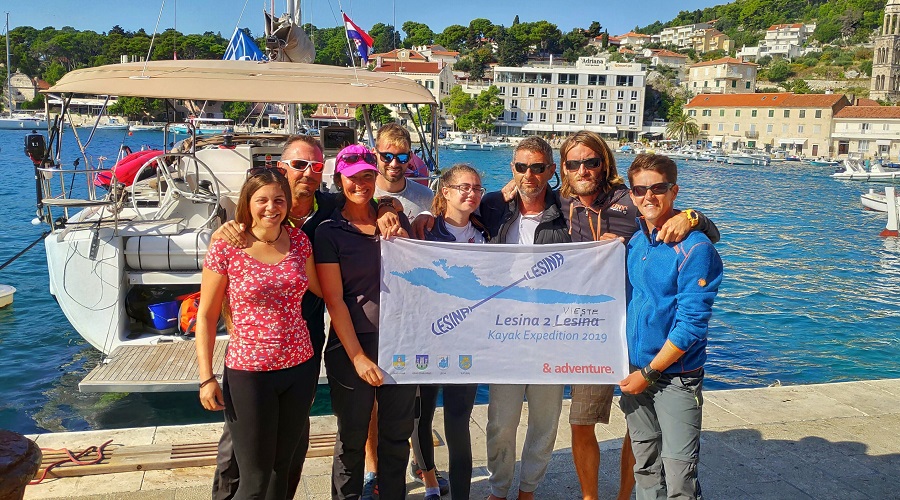
Congratulations to all. I feel quite exhausted just following it all.
And the good news is that you don't have to go all the way to Italy if you fancy a little kayaking in Dalmatia next summer. Check out the Kayaking with Vese experience in the video below.
Bon Jovi Signed Guitar Just One Hvar Celebrity Summer Memory at Gariful
October 26, 2019 - The A-List Hvar celebrity love is returning to Croatia's premier island, with some stars leaving gifts.
I had never heard of the island of Hvar until two days before my first visit in 2002, from which I emerged with a property purchase and a new home. My first impressions were that it was an island of breathtaking beauty and great food. But I really had no idea what treasure I had actually stumbled upon.
And as the years went by, and especially when I started research for the first modern guide book about the island, I was increasingly impressed. For Hvar has the oldest public theatre in Europe, the most UNESCO heritage of any island in the world, the most island sun in Europe, and so much more.
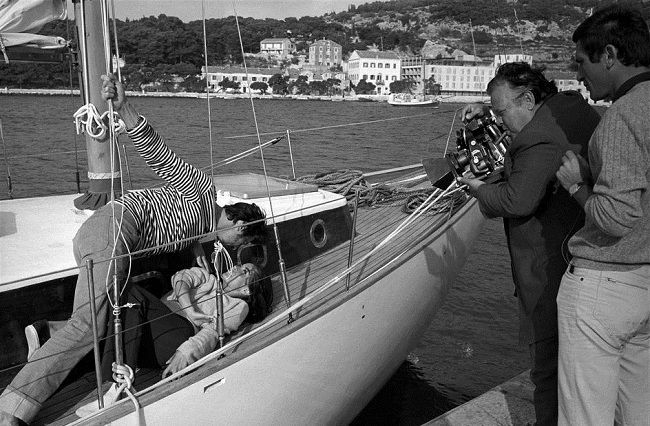
Including celebrities. Soon after I started writing about Hvar online, the celebrities seemed to be falling out of the sky and onto this idyllic island. Or, in some cases, falling into swimming pools as Prince Harry managed back in 2011.
Just a few weeks later, Beyonce turned up and revealed her baby bump to the world. Not only that, she went on to name her daughter Blue Ivy, after a blue ivy tree on Hvar.
The global pop star continued her love affair, returning to paradise once more as she recorded her love of Hvar and Dalmatia.
Writing about the Hvar celebrity arrivals was easy. And they kept on coming...

Tom Cruise was a high-profile 2012 arrival, the latest global name that had been coming to the island for many years - it was here that Orson Welles filmed The Deep (above) and Mrs JFK came water-skiing back in the 1960s, and Edward and Mrs Simpson popped in for lunch on honeymoon in 1936.

As the years went by, so too did the type of Hvar celebrity visitor evolve.
I had no idea what a YouTuber was when I was alerted that Joe Sugg and Oli White were heading to Hvar, but a little Internet research and a couple of phone calls later and I found myself interviewing the influential British YouTubers, location Restaurant Gariful. Gariful has long been known as THE destination for celebrity diners. Roman Abramovich, Bill Gates and Giorgio Armani have all dined there, with Armani putting the Hvar waterfront fish restaurant in his top 7 restaurants in the world.
And the YouTubers were impressed, and even more intrigued with the underfloor aquarium complete with baby sharks. Why not go for a swim with them, I suggested, surely that would be great YouTuber footage. And so filming began of the most-watched Hvar video of all time, almost 4.5 million views.
While many celebs visit the island away from the cameras - and Hvar is now for its egalitarian approach to its visitors, leaving the rich and famous to enjoy and relax - I have noticed less Hvar celebrity news pieces in recent years. That changed this year, as Hvar had a great season moving away from its party image to one of quality, culture and luxury. The opening of the oldest public theatre in Europe, built in 1612, after a 20-year renovation, was a very symbolic change in Hvar's direction. Take a tour inside in the video below.
This was followed in September with the much-anticipated opening of the first 5-star hotel on the island, Palace Elisabeth, hvar heritage hotel, located on the place where organised tourism in Europe began back in 1868.
And nowhere was the Hvar celebrity sightings more prevalent than at Gariful during a very busy 2019 summer.
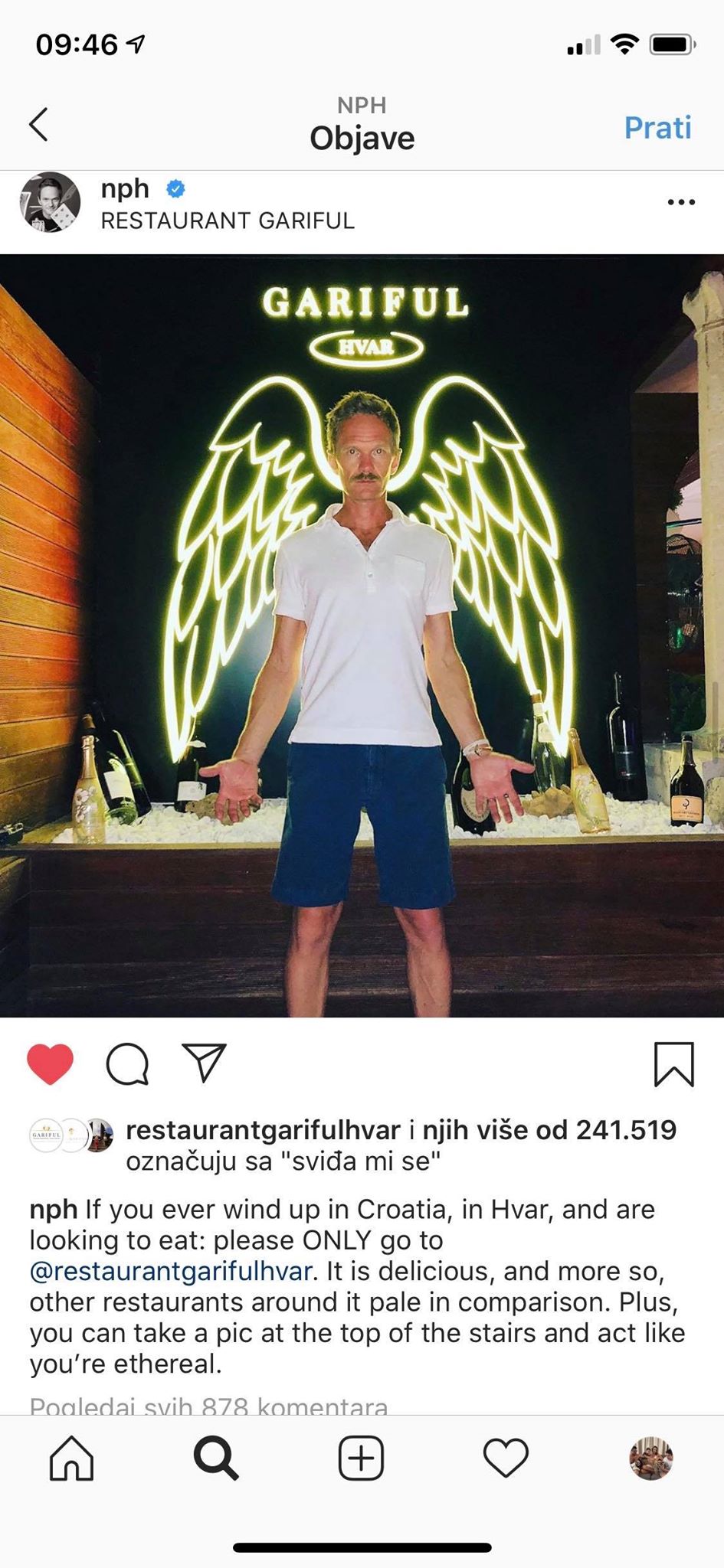
One man who seemingly had the time of his life, judging from his social media postings, was Hollywood star Neil Patrick Harris, whose 2-week stay at Villa Gariful behind the famous fish restaurant was filled with regular visits to his favourite restaurants.
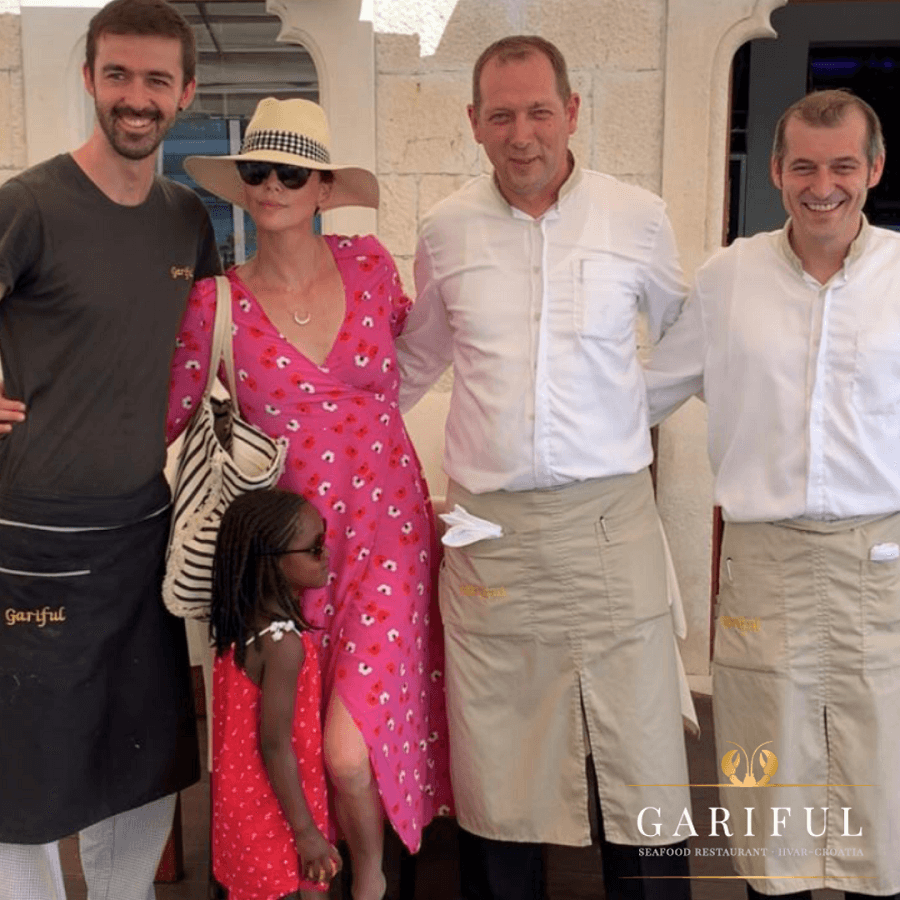
Charlize Theron was not only happy to pose for the cameras...
... but also keen to congratulate the chef on an amazing gourmet experience. Goldie Hawn was also a summer visitor from the world of Hollywood.
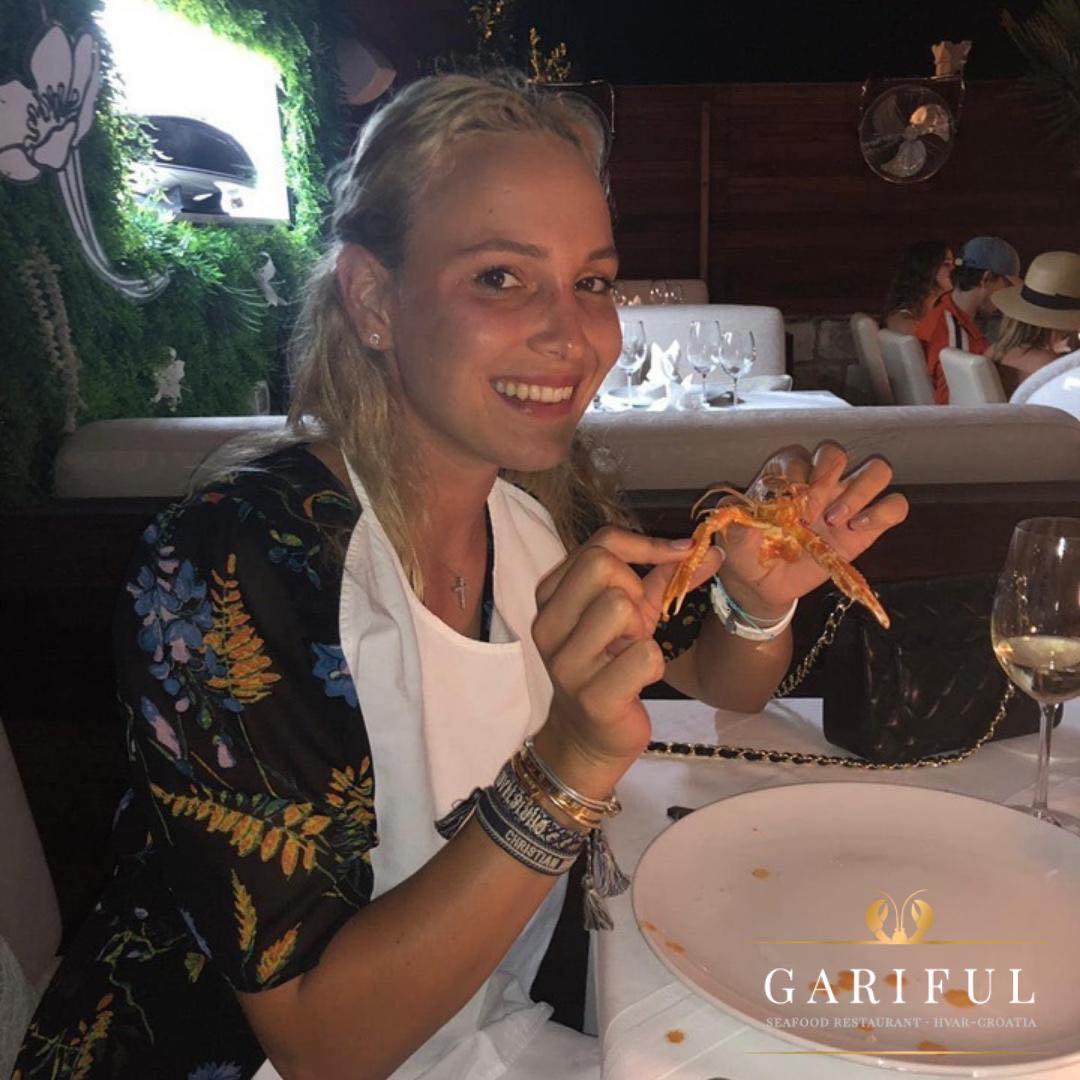
And if the Hollywood stars themselves were not able to make it, their families more than happy to enjoy Hvar hospitality. Sylvester may have been busy with work, but the rest of the Stallone family had a great time.
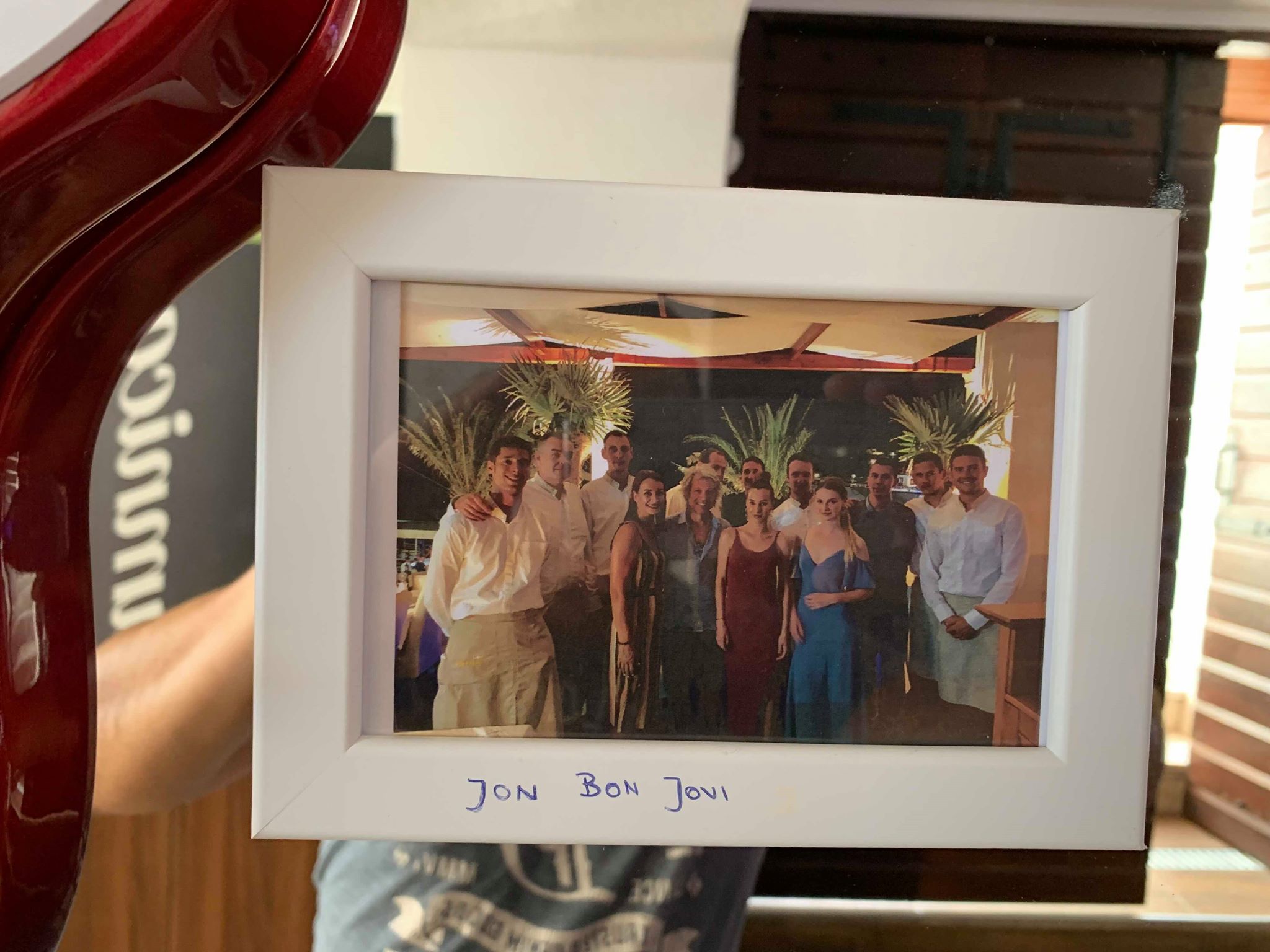
Rock star diners of previous summers included Bono Vox, but Jon Bon Jovi was the musical icon of 2019 on Hvar. And he left a gift...
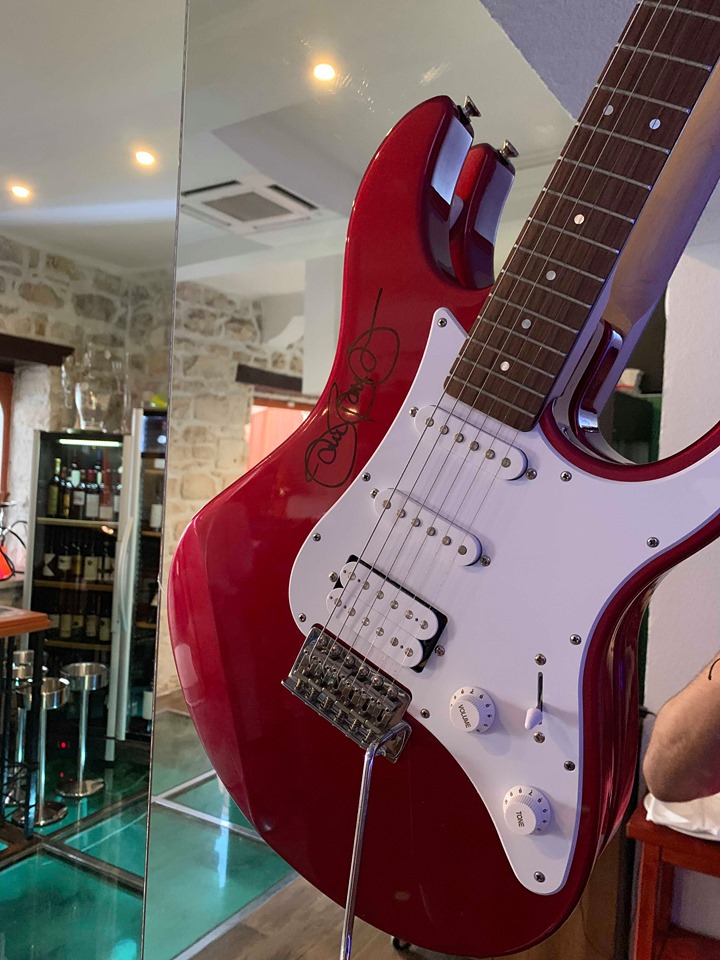
I don't know how many guitars Bon Jovi owns or how many times he eats out a month, but I can't imagine he leaves too many signed guitars in the restaurants he frequents.
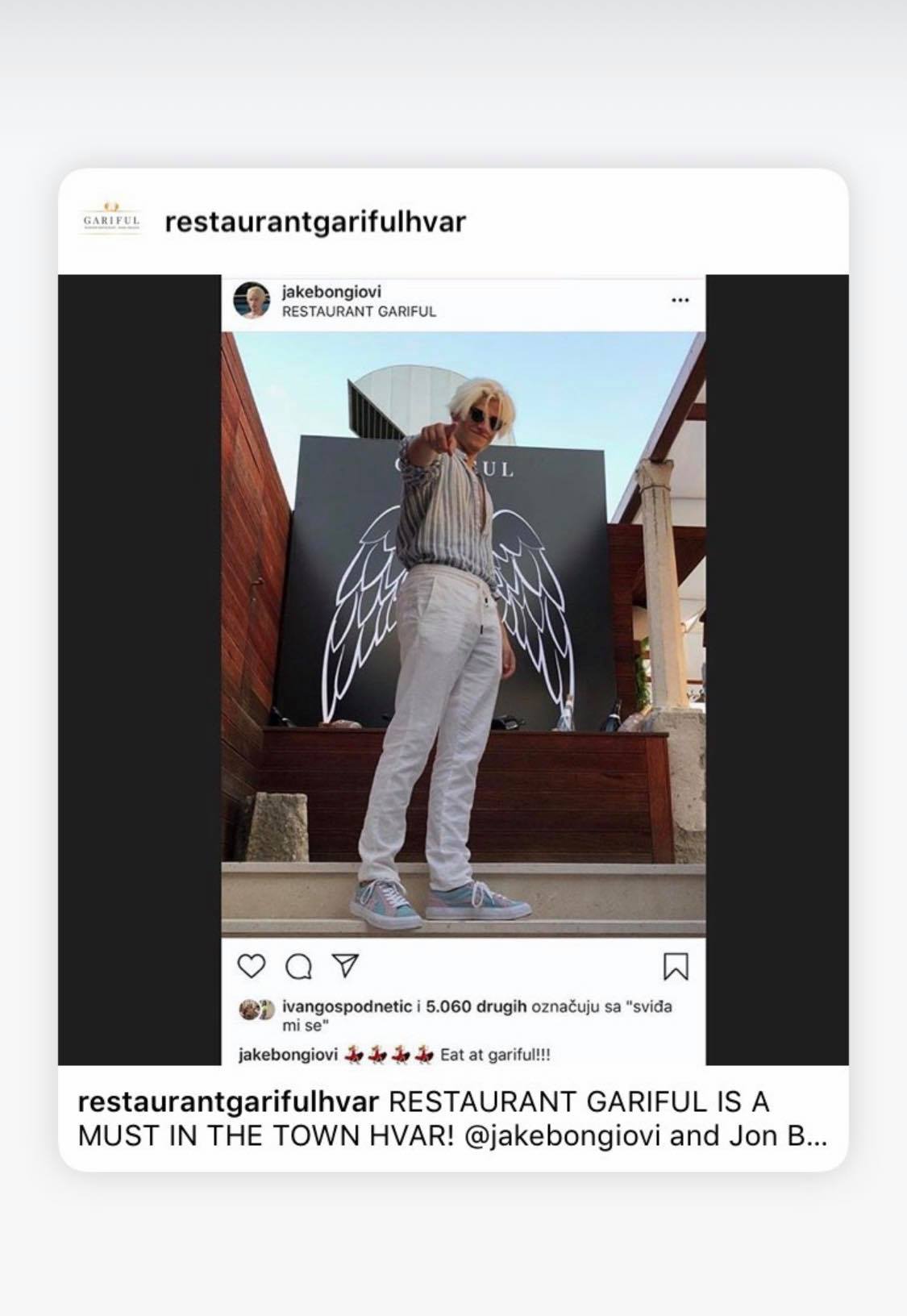
And while the guitar, which is now on display at Gariful, serves as a permanent reminder of the Bon Jovi visit to Hvar, there were plenty of Instagram memories in the opposite direction.

And it was not just famous visitors from Hollywood and the world of music - Prince Albert of Monaco was in very relaxed mood during his visit.
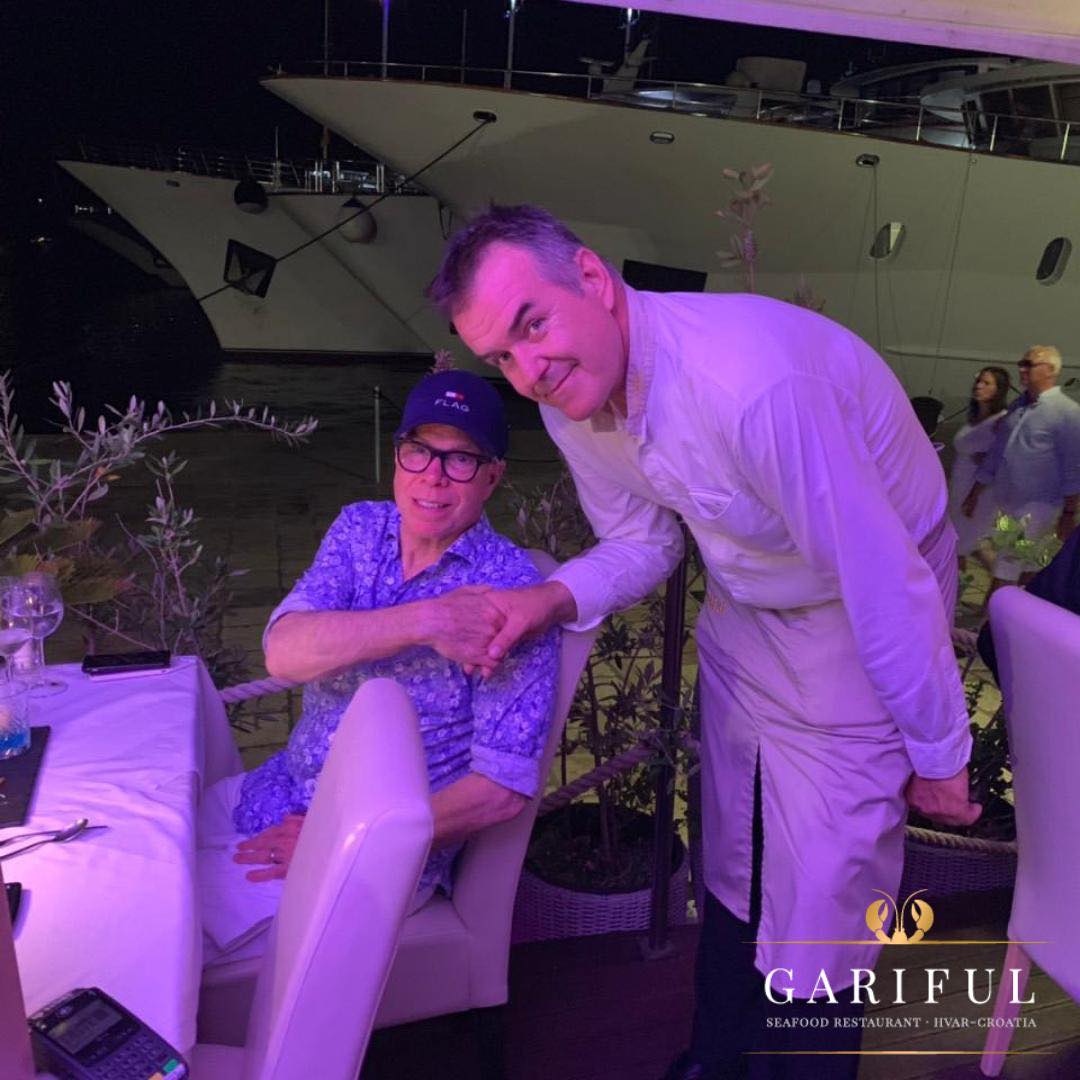
And where would the world of fashion be without Tommy Hilfiger?

And it looks like Hvar's tourism future is in safe hands. Goalkeeping legends Manuel Neuer and Keylor Navas enjoyed Hvar fish celebrities, just part of a world-class football team of visitors which included Dejan Lovren, Sami Kedhira, Ander Herrera and Samir Handanovic, while tennis legends included Jim Courier, Donna Vekic and Jelena Jankovic.
It is safe to say that Hvar is once more a top hit. The only question remains - who will we see on its famous waterfront next summer?
To learn more about the island, check out the Total Croatia Hvar in a Page guide.

